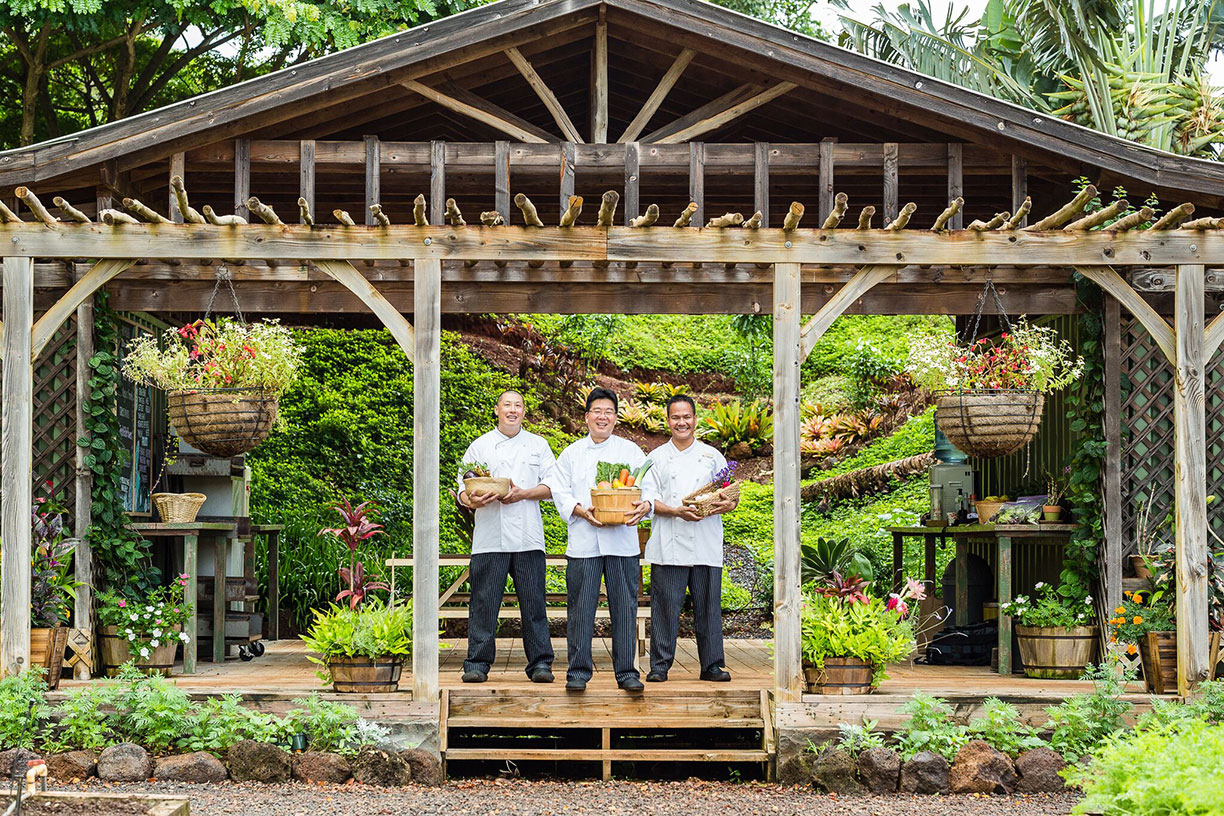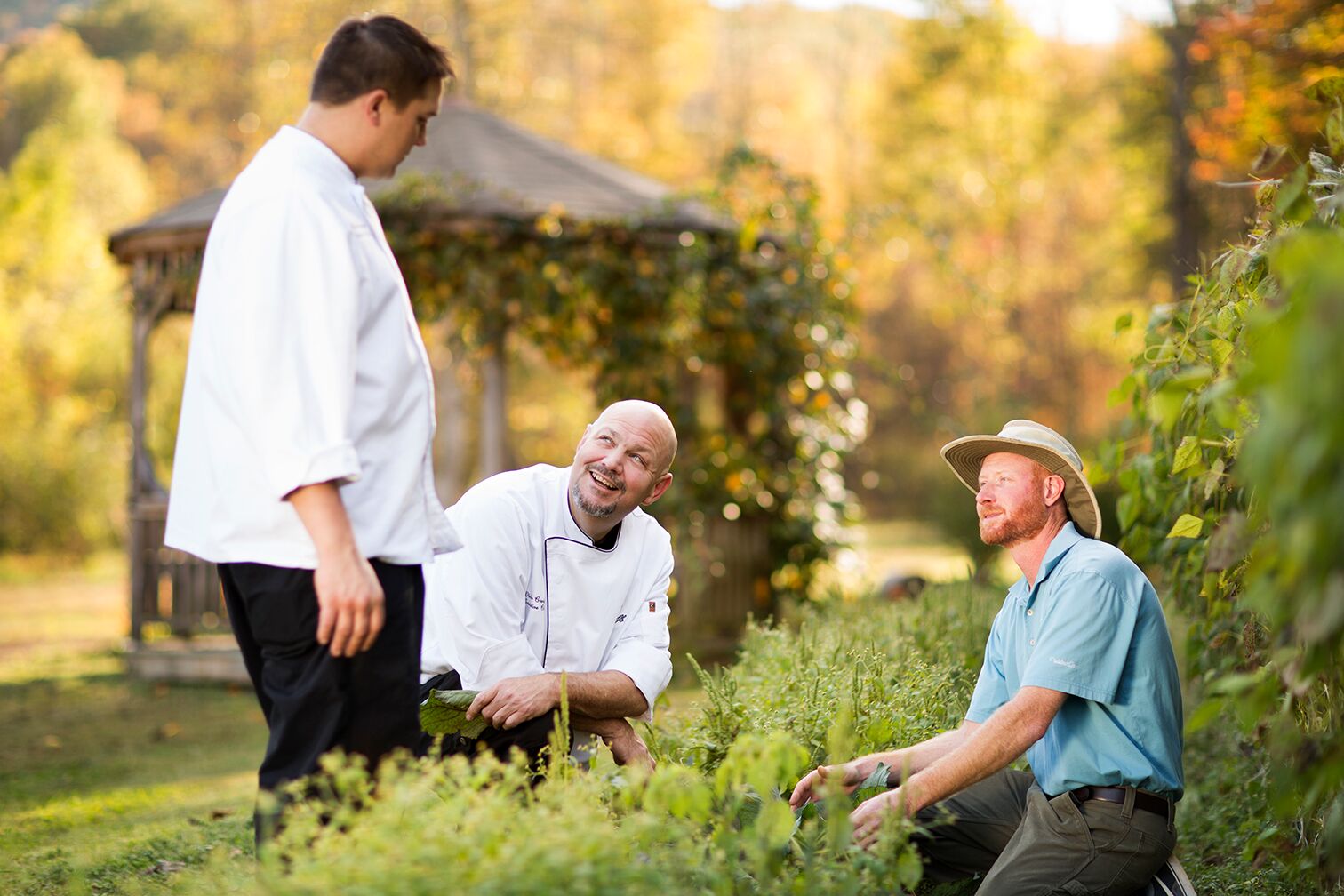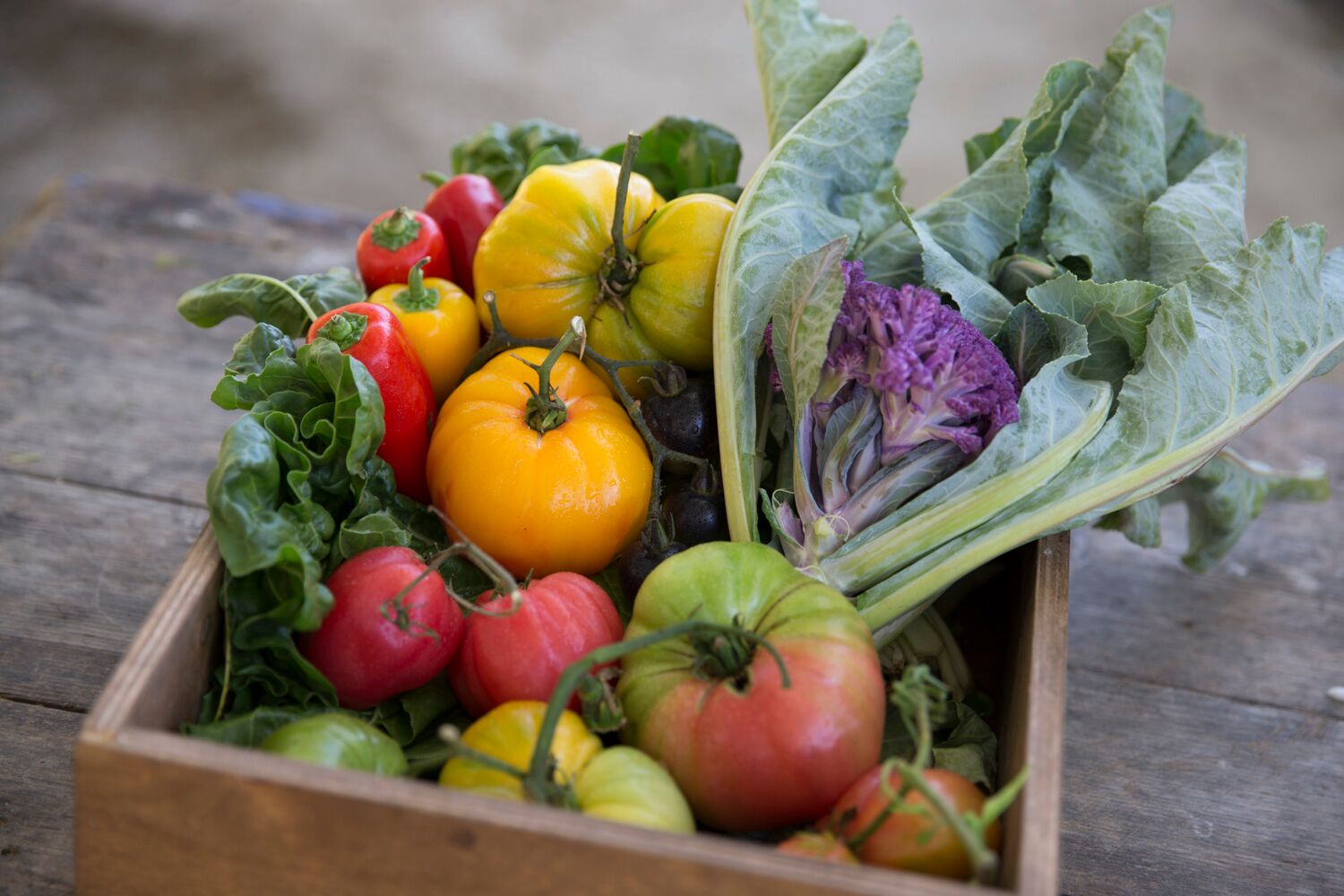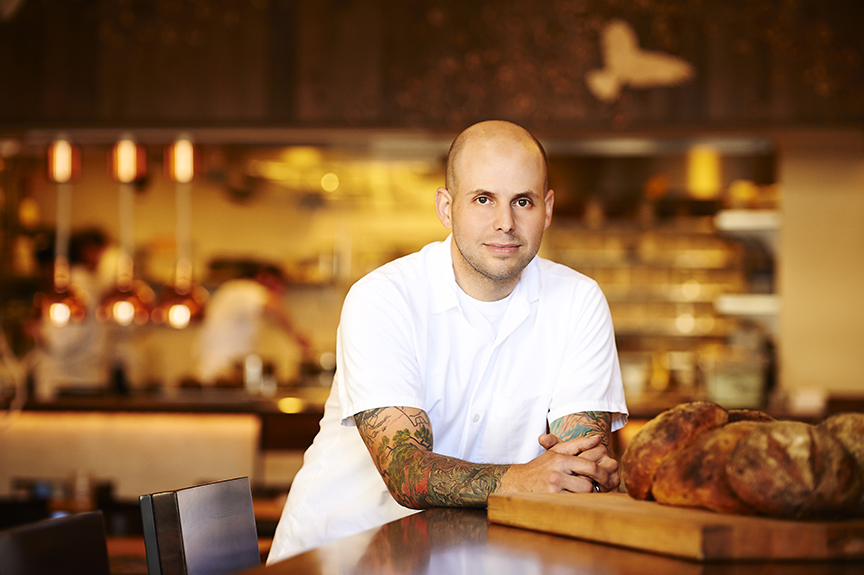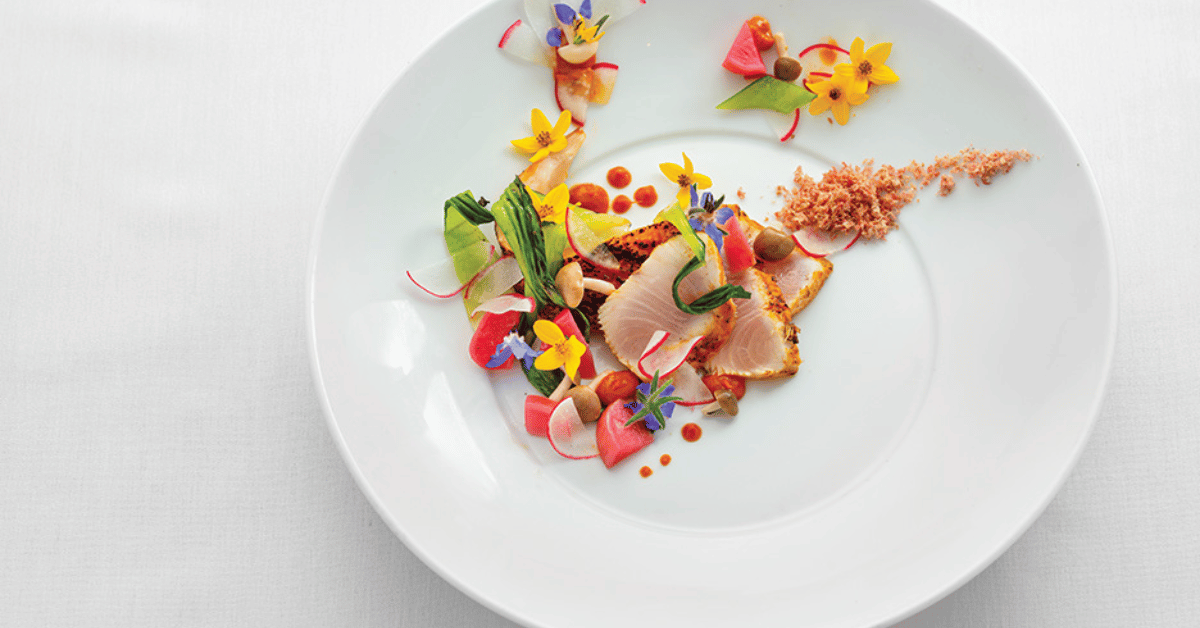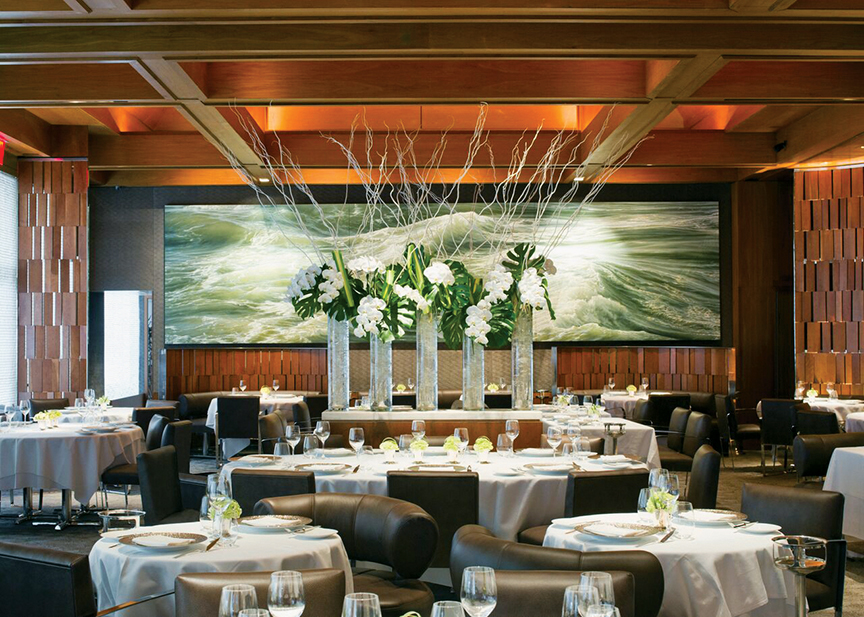
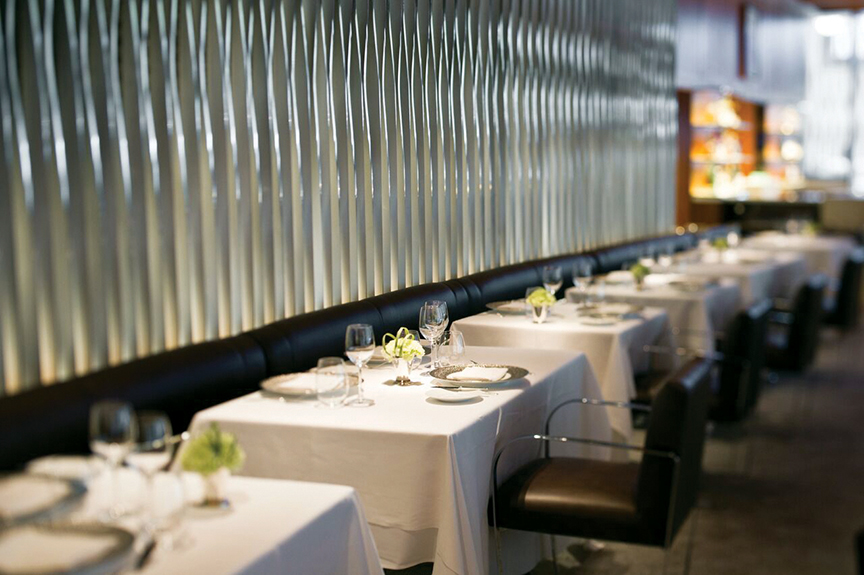
Photos courtesy of Le Bernadin
Overall, Americans are shunning haute cuisine, but for elite diners there remain plenty of opportunities for conspicuous consumption.
By Roger Grody
Generally, “fine dining” — typically evidenced by crisp white tablecloths, crystal stemware and formal service — is rapidly disappearing in America. However, for those restaurants that stubbornly adhere to tradition and insist on genuine luxury, the experience is elevated … along with the price.
Charlie Trotter, the renowned Chicago chef who died in his prime, insisted that fine dining actually represents good value, citing the superb ingredients and intensive labor (100 people from farmers to servers) that contribute to a world-class meal. Average Americans cannot afford mansions or yachts, but many can occasionally experience the world’s finest cuisine. The restaurants featured herein honor Trotter’s philosophy, with some pushing his principle to its limits.
Le Bernardin is one of New York’s temples of gastronomy, where chef/partner Éric Ripert has earned acclaim for fresh, seasonable seafood enhanced through sophisticated French technique. With options between $170 and $225 per person, the prix fixe menus at Le Bernardin are actually restrained for a Michelin three-star restaurant, but a couple can drop a bundle once caviar and wine are added.
“Luxurious service no longer equates to the stiff environment with formulaic interactions that was once popular,” reports Ripert, and while Le Bernardin has pioneered a more approachable experience, the chef/restaurateur still values tradition. “We continue to be a destination for special occasions, which is a large part of why we uphold some of our more classical dining requirements, such as gentleman wearing jackets,” he says. Allowing guests to visit the kitchen and take photographs with staff might not have been something his mentor Joël Robuchon would have encouraged decades ago, but Ripert views it as part of the evolution of fine dining.
While French cooking has the reputation for being the most expensive, it is Japanese cuisine — particularly the art of sushi — that is the priciest in America today. Discretely tucked into a diminutive space on Beverly Hills’ Rodeo Drive is Urasawa, whose entire seating is essentially comprised of just eight chairs at a sushi bar. There, for a flat fee of $425 per person (before tax, tip or a drop of sake), sushi chef Hiroyuki Urasawa personally pampers guests with an omakase (chef’s choice) meal in which extraordinary ingredients are matched by artistry on the plate.
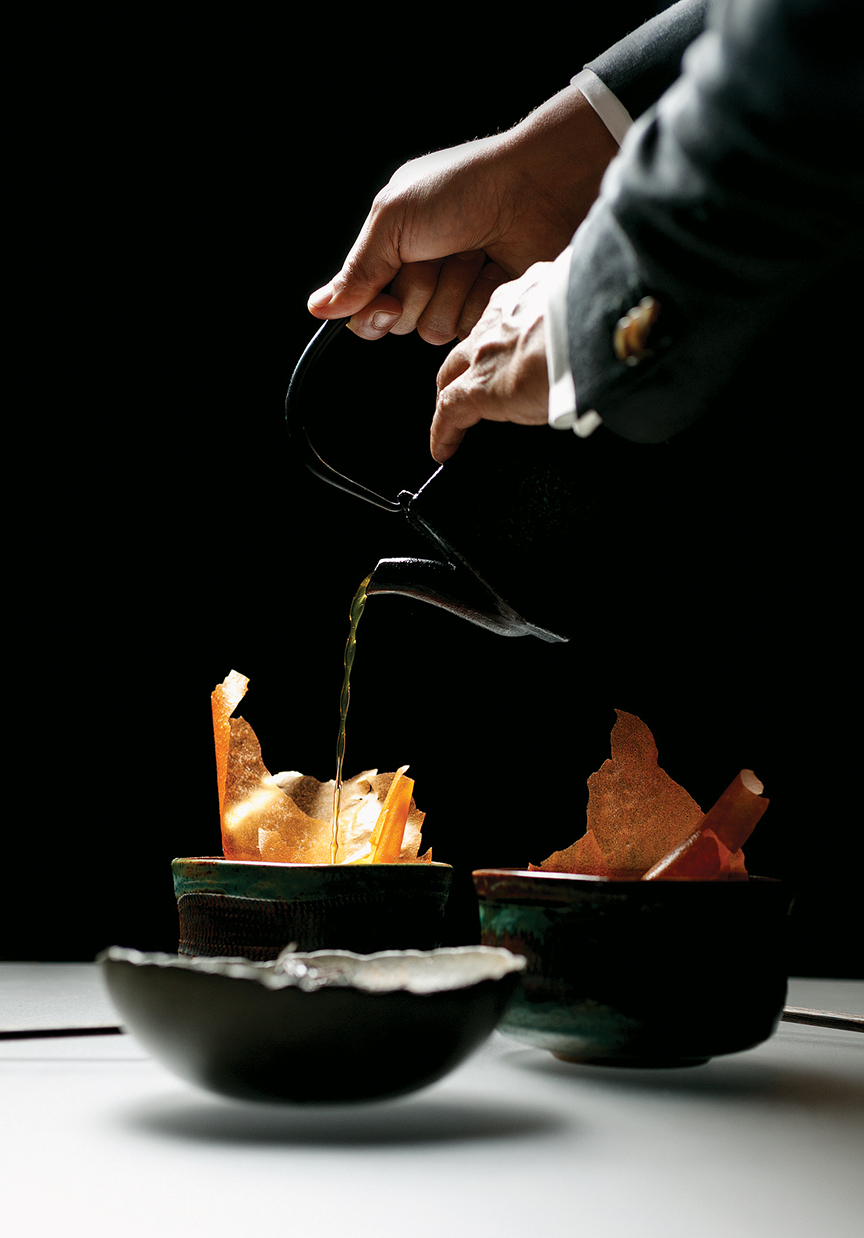

Photos by Allen Hemberger, interior by Matthew Gilson
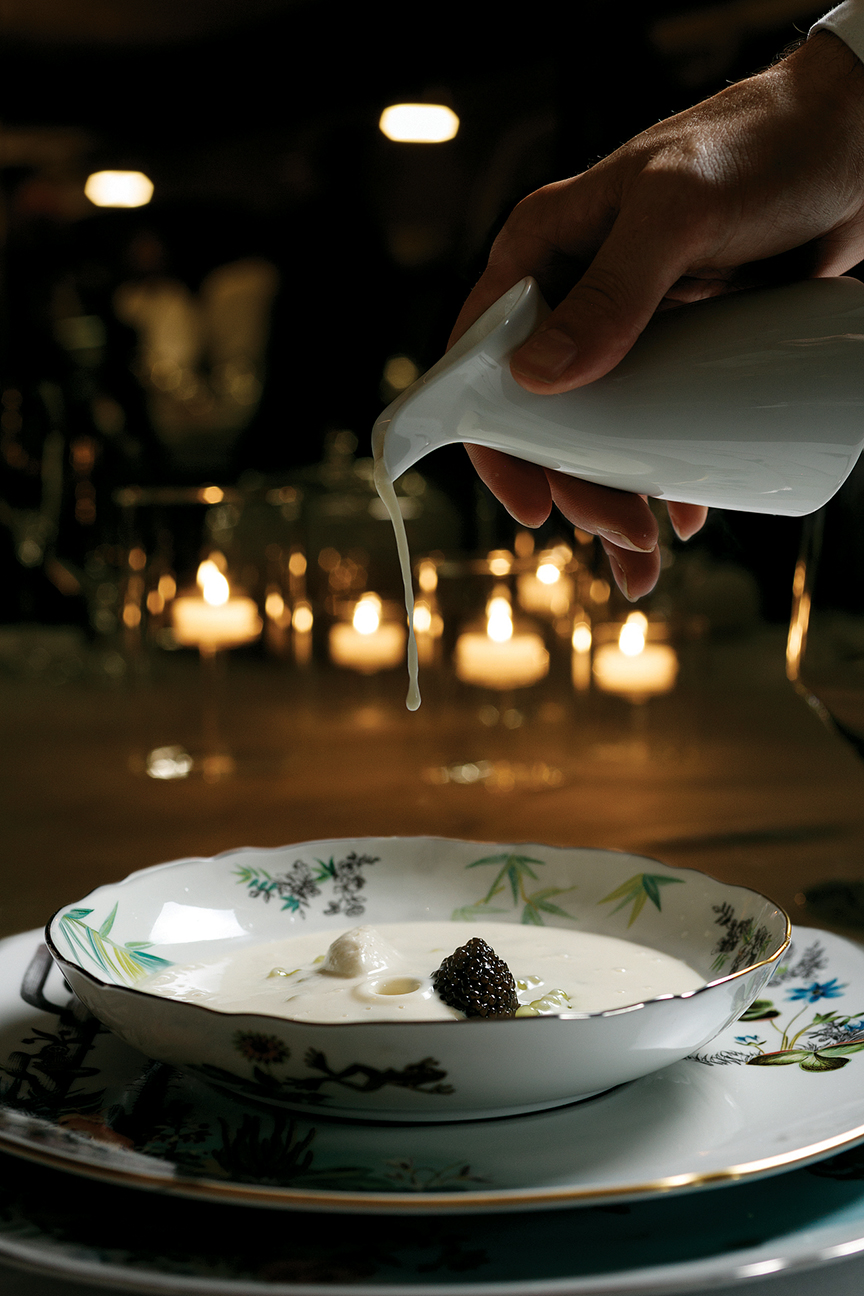
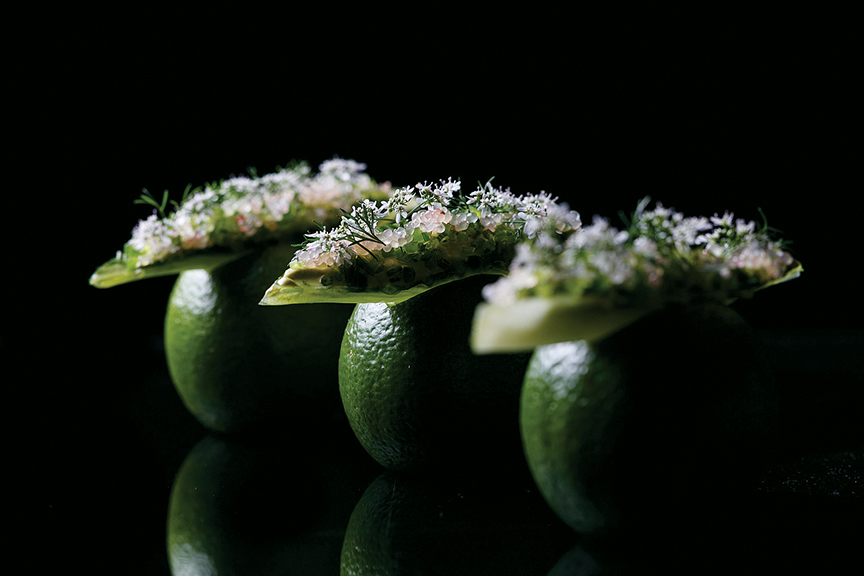
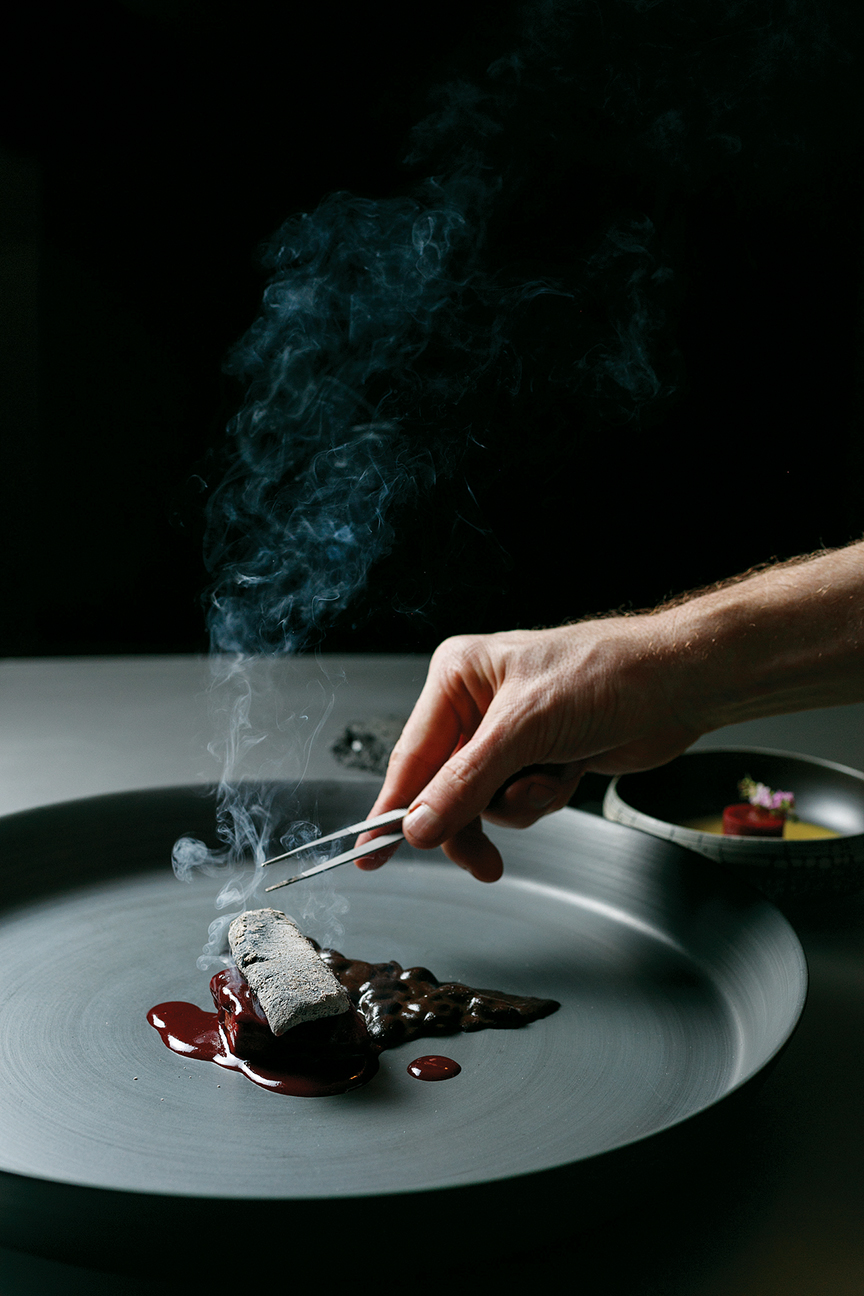
Urasawa-san is a protégé of sushi chef Masayoshi “Masa” Takayama, whose own restaurant previously occupied that same Beverly Hills space. When Takayama was lured to New York to open his 26-seat Masa at Time Warner Center, the prices went up and are now $595 per person, although gratuities are not accepted.
Masa’s sushi bar, a solid piece of hinoki (Japanese cypress), is sanded daily to create a luxurious tactile surface, while flowering branches of seasonal plants provide the only distraction from the master’s work behind the counter. A procession of glistening, edible jewels — the exquisite plating includes ample caviar, truffles and uni — comprise an unforgettable two dozen-course feast that most believe is worth the price.
Alinea, the renowned flagship of culinary innovator Grant Achatz, is sometimes mistakenly viewed as an elaborate stage for the chef/owner’s bag of molecular gastronomical tricks, but innovation alone does not earn three Michelin stars. While the interactivity and playfulness of the cuisine may turn off traditionalists who insist on the hushed formality of what typically passes for fine dining, the sophistication of Achatz’s ingredients, imagination and technique is undeniable. The price for this carefully choreographed presentation of culinary and performance art can reach $385 per person, prior to making a wine selection.
While acknowledging the “absurdity” of paying so much for a meal, Jeff Ruby, chief dining critic at Chicago magazine, insists the Alinea experience is a sound investment. “Someday, Alinea will be gone, and people will speak of it with awe, and its legend will grow,” he says. “Like people who brag that they saw Michael Jordan play in his prime, you can say you ate at Alinea. That is worth way more than $385 to me.”
Ruby believes even traditionalists can find pleasure with Achatz’s concept, as long as they go with an open mind. “People walk in with a chip on their shoulders and Alinea knocks the chip off and turns it into some kind of dehydrated truffle orb,” quips Ruby, insisting Achatz and his crew deliver on their promise night after night.
Located in a posh hotel 20 miles north of downtown San Diego is Addison, where 22-karat gold-trimmed doors open into a soaring foyer while four limestone fireplaces warm the classically inspired premises. In the kitchen, Executive Chef William Bradley prepares a contemporary French cuisine while $10,000-plus treasures are stocked in the wine cellar. Although the chef’s 10-course tasting menu is a relatively manageable $250, Addison recently hosted a Krug Champagne dinner that at $1,000 per head is extravagant by any standard.
“At Addison, every element is fine-tuned through the lens of creating the best and most memorable dining experience possible for our guests from the moment they walk through the door,” reports Bradley. Noting that many diners are celebrating special occasions or have traveled a great distance, he adds that small details (e.g. generously spaced tables, stools for ladies’ purses) are the foundation of the guest experience.
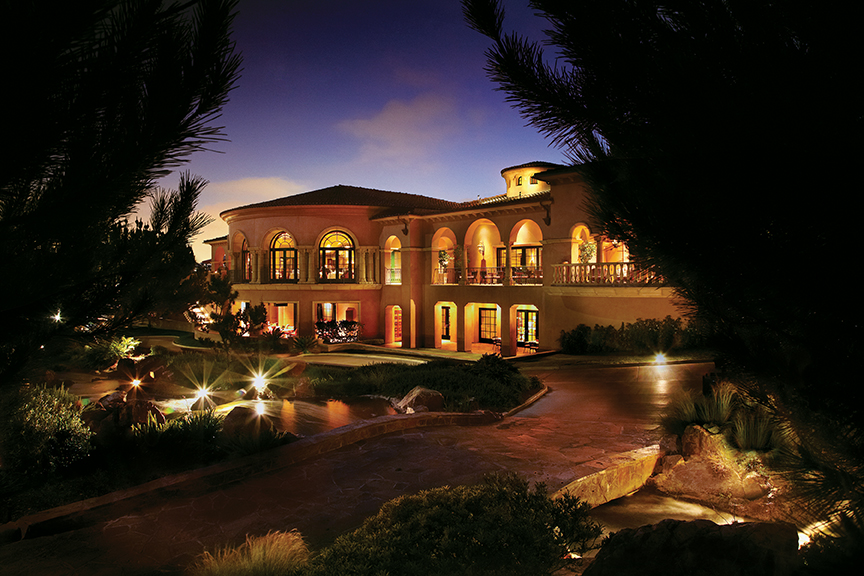
Photos courtesy of Tory Kooyman and Jakob N. Layman
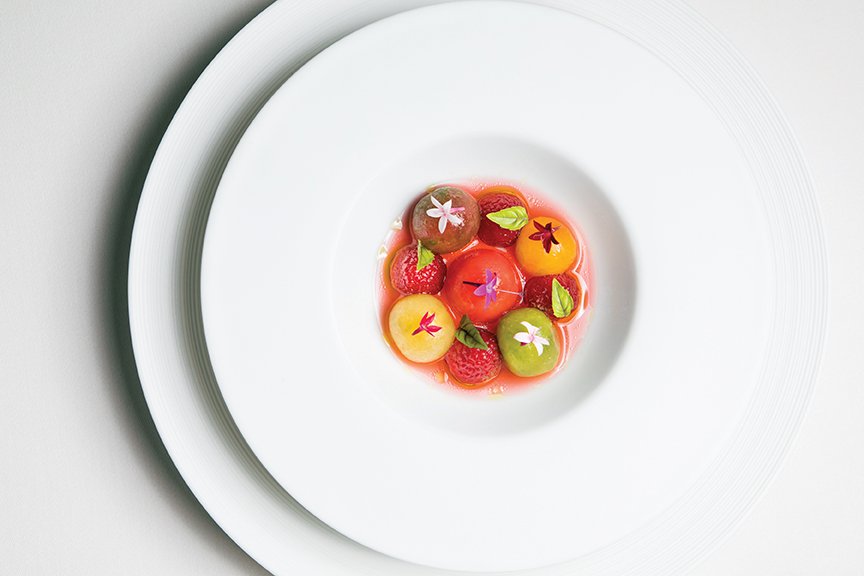
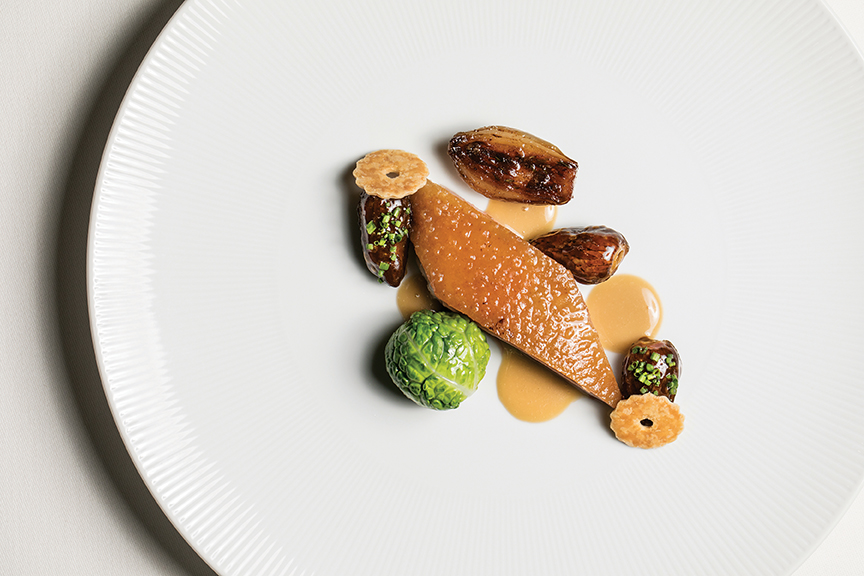
“Hospitality is timeless, as is the desire to be transported,” says Bradley, noting that the dining experience at Addison — it is tucked away in the hills above Del Mar — echoes its physical separation from metropolitan San Diego or L.A. “In an era where we’re so connected to technology, it’s more important than ever to maintain fine dining traditions that separate our guests from the stress of their daily routines,” suggests the chef.
Addison’s bar is currently dispensing a $250 cocktail called the Corpse Reviver XIII, a reimagination of a classic libation with roots in the 19th century. This gold dust-embellished version contains Adrien Camut Rareté (a Calvados so rare only 10 bottles are allocated to the U.S. annually) and 40-year-aged Rémy Martin Louis XIII Cognac. With its price equivalent to the tasting menu, this is clearly an indulgence worth lingering over.
In San Francisco, Saison ranks as the most exclusive and expensive restaurant in town, where exquisitely presented contemporary American fare is served in a space where the boundaries between dining room and kitchen are all but erased. A procession of nearly 20 small courses, which changes daily and can be tailored to the preferences of individual diners, carries a tariff of $398 —before even exploring Saison’s world-class wine list.
In Las Vegas, where winners and losers alike are as predisposed to consume opulent cuisine as they are to purchase Louis Vuitton bags, every major hotel has at least one ultra-high-end dining room. At Caesar’s Palace it is the eponymous restaurant of Guy Savoy, one of Paris’ Michelin three-star stalwarts, where the “Prestige Tasting Menu” runs $385 per person and premium wine pairings add another $375.
At Twist, a celebrated dining venue at the Mandarin Oriental Las Vegas, Chef Pierre Gagnaire (another giant of the Parisian dining scene) presents what may be the luckiest menu on the city’s legendary Strip. A seven-course meal is paired with seven fine wines to comprise a memorable gastronomic experience, and hopefully its $777 per person investment can be recouped with some additional sevens in a nearby casino.
At the Mandalay Bay’s Fleur in Las Vegas, even the ultimate comfort food can inflict extensive damage to one’s budget. There, chef/owner Hubert Keller applies the city’s legendary glam to the humble hamburger, layering foie gras and truffles over a wagyu beef patty. It arrives with a bottle of 1995 Château Pétrus, one of the world’s most treasured wines, followed by a $5,000 tab.
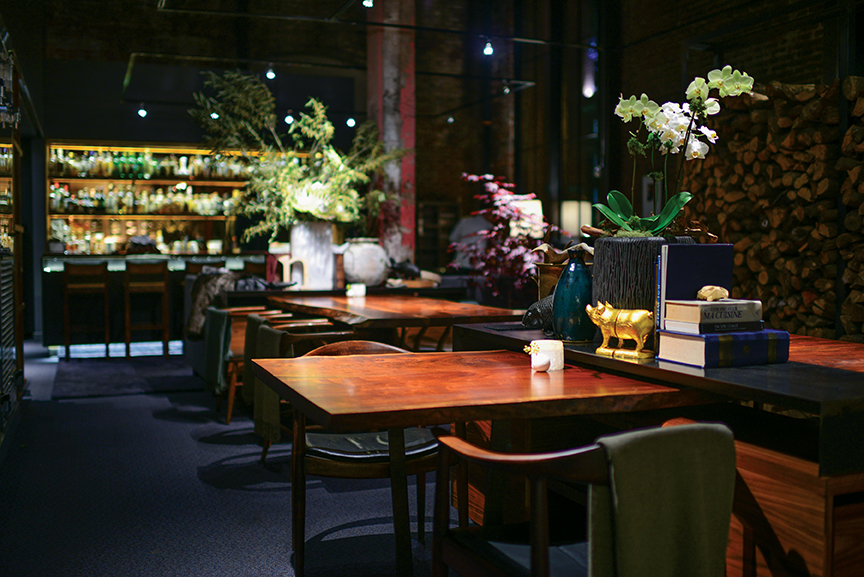
Photos by Bonjwing Lee
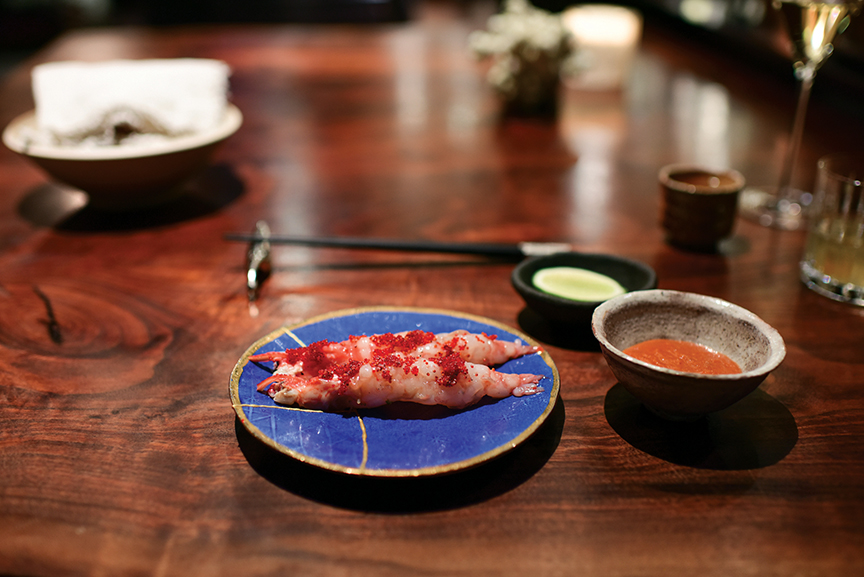
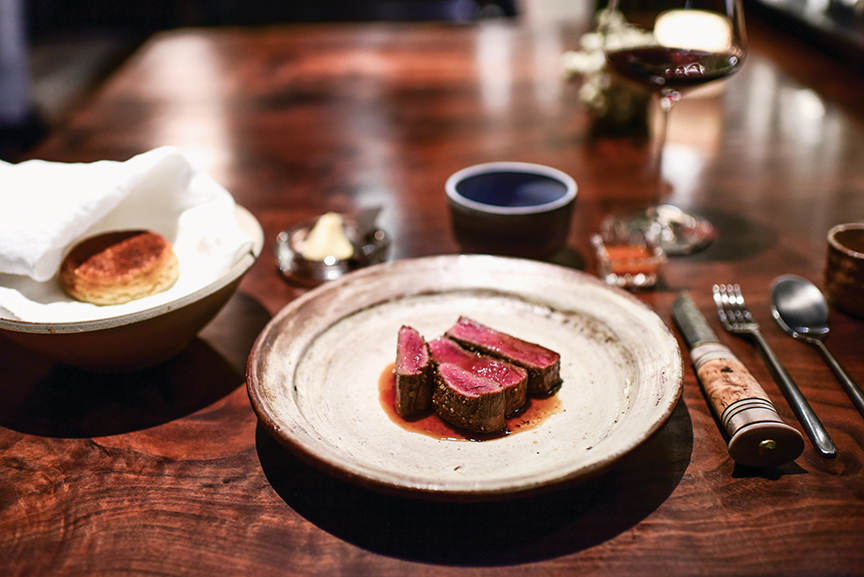
Addison • San Diego • www.addisondelmar.com
Alinea • Chicago • www.alinearestaurant.com
Fleur by Hubert Keller • Las Vegas • www.hubertkeller.com
Restaurant Guy Savoy • Las Vegas • www.caesars.com
Le Bernardin • New York • www.le-bernardin.com
Masa • New York • www.masanyc.com
Saison • San Francisco • www.saisonsf.com
Twist • Las Vegas • www.mandarinoriental.com/las-vegas
Urasawa • Beverly Hills • http://urasawa.cafe-inspector.com
The wildly popular social movement “farm-to-table” encourages sourcing food locally, so that consumers know exactly where their food came from. Knowing the origin of your food encourages the freshest dining, and that can be found in these three dining options. These farm-to-table experiences have taken sustainability to a luxury level.
OUTSTANDING IN THE FIELD
Originally staging a handful of events in 1999, luxury farm-to-table dinner service “Outstanding in the Field” today stages 100+ multi-course feasts every year, from coast to coast across North America to all around the world.
Founded in 1999 by artist and chef Jim Denevan, “Outstanding in the Field” originally was a radical idea to switch up the traditional convention of dinner. Rather than sourcing ingredients and bringing them to the restaurant, Denevan’s vision was to create a restaurant at the source, where guests would enjoy a communal meal and the farmer’s story could be told and celebrated. A single long table is set at an extraordinary site, and guests dine outdoors on the food grown at the source.
“Our mission is to get folks out to the places where the food comes from and honor the people whose good work brings nourishment to the table,” says chef and artist Jim Denevan. “Our roving restaurant without walls may be located wherever good food comes from. There are no boundaries.”
“Outstanding in the Field’s” culinary caravan has visited all 50 U.S states and 15 countries around the globe. The #TabletoFarm tour season runs May through November, with a smaller winter tour in January/February to warm-weather spots like Florida, Hawaii and Mexico.




STUDIO IN MONTAGE LAGUNA BEACH, CALIFORNIA
Overlooking the Pacific Ocean in Laguna Beach, Studio is Montage Laguna Beach’s five-star free-standing fine dining restaurant. Studio prides itself on serving innovative modern cuisine. While Studio is known for its tasting menus and incredible service, it is also a Wine Spectator Grand Award winner, with approximately 2,500 wine selections and 30,000 bottles in inventory.
Studio’s showstopper is the 1,000-square-foot raised bed garden, which provides many of the ingredients for the restaurant’s signature cuisine. The garden is currently growing cucumbers, cherry tomatoes, Swiss chard, Valencia oranges, artichokes and edible flowers, to name a few. The culinary team at Studio uses the garden’s bounty in everyday cooking, especially in the restaurant’s gourmet vegetarian tasting menu, and also for fresh cocktail garnishes throughout Montage. The garden can seat up to 50 guests.
FLORA’S FIELD KITCHEN, MEXICO
Flora Farms is a 25-acre organic working farm at the foot of the Sierra de la Laguna Mountains in San Jose del Cabo, Mexico, and is home to Flora’s Field Kitchen, a field-to-table restaurant set amongst idyllic organic fields and gardens.
The original Flora Restaurant was in San Jose del Cabo, but after 5 years in town, the owner decided she would rather bring the restaurant to the farm instead of the other way around. Flora’s Field Kitchen prides itself on serving only what it has grown, even nixing beef from the menu, as it is not sustainable in the Baja region.
Flora’s has an onsite bakery firing up artisan breads, a butcher-shop, a brewery, and a wood-fired oven that serves up 15 types of Neapolitan-style pizza.. The restaurant also offers cooking classes several days a week.
Flora Farm is available for private gatherings and special occasions, with customizable event menus.




AGRICOLA FORE PORTA, ITALY
Only accessible on foot, this organic agriturismo, or farm resort, only uses seasonal, organic products, with the famous Amalfi lemons at the forefront of the fresh cuisine.
For Italians, the idea of combining agriculture with tourism is an old tradition, and this agriturismo started generations ago, when the farm was an old papermill. Agricola Fore Porta today offers a daily menu, which includes traditional courses prepared only with seasonal products picked freshly every morning, and Mediterranean cooking lessons, where participants will learn how to prepare local recipes.
Innovative pastry chefs around the world are presenting cutting-edge creations while respecting centuries-old traditions.
Most celebrity chefs specialize in savory courses while those who master sweets — the very dishes that put an exclamation point on any memorable meal — toil in relative obscurity. Culinary professionals, however, concede that desserts are at least as demanding and complex, requiring a greater appreciation of science and precision, not to mention artistic flair.
Paris is filled with extraordinary restaurants and pâtisseries, but Pierre Hermé may be the City of Light’s leading innovator of sweets.
Long before classic Parisian macarons (delicate meringue sandwich cookies not to be confused with American macaroons) began drawing attention worldwide, Hermé was revolutionizing the confection from his Paris studio. His audacious approach has become so trendsetting that seasonal releases of his new flavors are as anxiously awaited as the lines of haute couture turned out by the city’s fashion designers.
Anise and saffron, chocolate and foie gras, caviar and walnut. These brazen yet balanced flavor combinations represent the imaginative macarons dispensed at Hermé’s jewel box-like stores, which have spread throughout Europe, the Middle East and Asia. Monsieur Hermé’s magic also extends to cakes and tarts such as his “Ultime,” a sleek, seductive disk of Belizean dark chocolate cream and Madagascan vanilla ganache.
Pierre Hermé’s macarons may be the most elegant take-out snacks in Paris, but extraordinary plated desserts are found at the city’s Hôtel Plaza Athénée. Maintaining the property’s world-class culinary standards — it is home to an Alain Ducasse restaurant earning three Michelin stars — is Angelo Musa, a world pastry champion and recipient of the coveted Meilleur Ouvrier de France.

“I’m inspired by the changing seasons, with each turn I discover and rediscover unique flavors,” says Musa. His creations are sophisticated, but the chef has a restrained approach to presentation. “I don’t favor art at the expense of taste,” says Musa of a philosophy he has maintained throughout his career. “Finding the balance between tastes and textures allows staging to be more harmonious and attractive, and when the taste transmits a sensibility far beyond the visual, the aestheticism offers an immediate emotion,” he explains.
Nearby, on the other side of Place de la Concorde, is Paris’ Le Meurice, a lavish hotel dressed in gilt, crystal and silk. Cédric Grolet, the property’s 32-year-old pastry chef, was named “Best Restaurant Pastry Chef in the World” (2017) by Les Grandes Tables du Monde, as well as “Best Pastry Chef” (2018) by France’s influential Gault Millau guide. His desserts at the hotel’s magnificent dining room, Le Meurice, and pastries for afternoon tea at Restaurant Le Dalí have generated considerable buzz.

Cédric Grolet

Rubik’s Cube
While a serious artist, Grolet indulges his playful side in fanciful yet elegant pastries that resonate with customers. He is renowned for his fruit sculptures, confections so realistic they mirror their inspirations with incredible precision, and his interpretation of a Rubik’s Cube, a dazzling cake sculpture consisting of 27 ganache- and gilt-clad petit fours.
“The colors, as well as the textures and decorations, are from nature,” says Grolet of the Cube, who adds for emphasis, “This is essential.” Like Musa, Grolet’s menu is dictated by seasonality and he regularly tastes the savory dishes to ensure his finales are complementary. “This means taking into consideration the weather, having a dash of boldness and adding last-minute touches,” he explains.

Johannes Bonin

Mascarpone Cheesecake
Although innovators, Musa and Grolet are classicists at heart, while Oriol Balaguer experiments with molecular gastronomy to perfect pastries and chocolates showcased at his high-end boutiques in Barcelona and Madrid. Earning an award as “Best Dessert in the World” is a glossy study in chocolate in which Balaguer presents eight distinct textures of the sexy ingredient.
At his eponymous pâtisseries in Tokyo and Paris, Sadaharu Aoki applies classic French pastry technique to traditional Japanese ingredients, resulting in matcha (green tea) napoleons, black sesame éclairs or macarons infused with wasabi or yuzu. Aoki’s sophisticated aesthetics, displayed in both his cross-cultural desserts and sleek boutique interiors, play equally well in Japan and France.

Thomas Raquel

APPLE Brown Butter Mousse
The Japanese-born Aoki mastered his craft in Paris, but the city’s claim to being the epicenter of pastry art is being challenged as French-trained chefs scatter across the globe. At Dubai’s Burj Al Arab Jumeirah, the iconic sail-shaped structure that has been called “the world’s first seven-star hotel,” French-born Johannes Bonin turns out edible art for well-heeled guests.
“As a global culinary hub and home to diverse nationalities, the Middle East inspires chefs to put their creative skills to the test by making the most of local ingredients,” reports Bonin. Explaining his personal approach, he states, “I choose a premium-quality product, then add just one or two flavors to complement that main ingredient and give it an original twist.” At Burj Al Arab, Bonin deviates from his own French traditions, creating desserts that are fun, less sweet and relatively healthy. He believes presentation should be secondary to taste, but recognizes its power in the age of Instagram and applies his share of gold leaf at a hotel renowned for luxury.
At New York’s Le Bernardin, America’s most honored seafood restaurant, 31-year-old executive pastry chef Thomas Raquel is challenged with maintaining the perfection of preceding courses from celebrity chef/co-owner Eric Ripert, whose cuisine has earned three Michelin stars. Each of Ripert’s dishes tend to showcase one primary ingredient, and Raquel is similarly focused. “A single ingredient or classic dessert is the star on the plate, then I add my own twist — whether it’s in the presentation or an unexpected element — to elevate the ingredients and make the dish memorable and unique,” he explains.
Whether interpreting a classic Mont Blanc or reimagining a Black Forest cake, Raquel has a thoughtful approach to plating. “I always consider flavor first, then aim for a presentation that balances organic shapes and clean lines,” says the chef, who adds, “I want each plate to be both simple and unexpected…. I love when the plating of a dessert can offer guests a little surprise!”
With its salad-picking supermodels and an obsession with health, one would not expect Los Angeles to be promising territory for desserts. But The Peninsula Beverly Hills’ Stephanie Boswell is among a cadre of innovative young pastry chefs in her native city. At The Belvedere, the hotel’s fine dining venue, she is known for literally transforming desserts into works of art.

Mascarpone Cheesecake

Stephanie Boswell

Cassis Plum

Janice Wong
Boswell’s Fabergé eggs — chocolate shells hand-painted with floral designs and embellished with glitter — are exquisite presentations. “I wanted the egg to be this perfect, precious, austere thing that comes to your table and you have to smash it to eat it,” says the executive pastry chef of her edible performance art. Inside, pretenses are dropped in favor of nostalgic fillings like s’mores or Boswell’s upscale take on a PB&J sandwich. She also creates cream puffs emblazoned with pop art images from masters like Warhol, Lichtenstein or Robert Indiana, whose original work is on the wall.
“My work is greatly influenced by the world of art,” explains the chef, who as a kid spent every weekend at a different museum. “I heard the phrase, ‘DON’T TOUCH THAT!’ a lot and I think it made me want to create art that was made with the intention of being touched, messed with and changed by the viewer,” recounts Boswell. Ultimately, she recognized pastry was the perfect medium for that approach.
The traditions of East and West collide in Hong Kong, where chef Janice Wong — the native Singaporean was mentored by Hermé and Balaguer — applies classic technique to Asian ingredients at Cobo House. Wong creates the entire menu but reinforces her reputation as a pastry chef favoring avant-garde presentations. Inspired by the Japanese cherry blossom is a half-sphere of blackcurrant and white chocolate with a crater filled with pink foam created from red shiso leaf liqueur.
Dessert, anyone?
Photos courtesy of Georges Biard, Angelo Musa, Pierre Hermé, Thomas Dhellemmes, Pierre Monetta, Stu Williamson, Daniel Krieger, Ryan Forbes, Cobo House, Burj Al Arab, Le Bernardin, Peninsula Beverly Hills
Sweet Spots
Burj Al Arab Jumeirah
Dubai
www.burjalarab.com
Cobo House
Hong Kong
www.cobohouse.com
Le Bernardin
New York
www.le-bernardin.com
Le Meurice
Paris
www.dorchestercollection.com
Oriol Balaguer
Barcelona and Madrid
www.oriolbalaguer.com
The Peninsula
Beverly Hills
www.beverlyhills.peninsula.com
Pierre Hermé
Paris and elsewhere
www.pierreherme.com
Hôtel Plaza Athénée
Paris
www.dorchestercollection.com
Sadaharu Aoki
Tokyo and Paris
www.sadaharuaoki.com
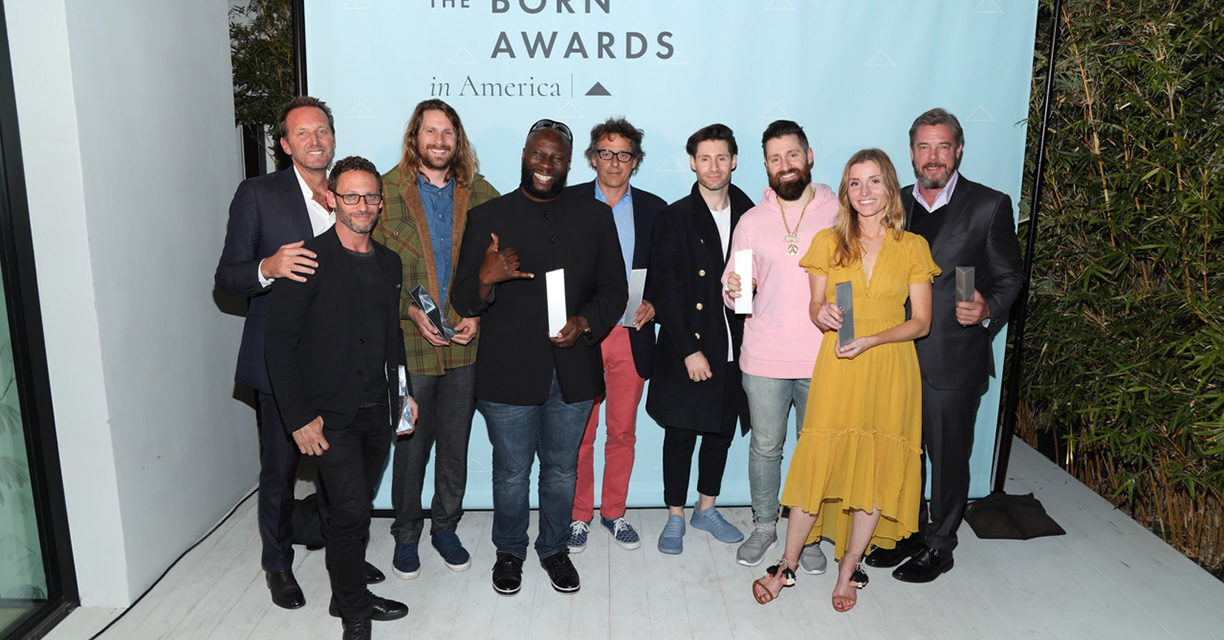
2018 Winners in Six Categories Announced at Private Dinner at Beverly Hills Home
Founded in Europe in 2010 by Jean-Christophe Chopin (architect of E-Trade Europe), the BORN Awards, which celebrate creative achievements across multiple categories of the design-led lifestyle, landed on American shores. The BORNS are the first U.S.-based regional competition recognizing work that strives to enhance people’s lives through aesthetics and functionality. All of the winners, both emerging and established men and women, invented something beautiful and carried their visions to society.
Operating in six countries, the BORN Awards are the premier platform for honoring and empowering artists while providing exposure to some of the world’s most influential retailers, brands and industry professionals. The winners from each region, now including the U.S., are invited to present their creations during an exclusive exhibition at Milan Design Week each year, and to participate in The BORN Conversations, an exclusive series of fireside chats held with renowned thought-leaders about the intersection of creativity and business. Once all of the regional winners are selected, they will go on to compete against one another in the global final held in London each year.
The theme of the 2018 competition is “Peerless,” which aims to elevate singular creations that combine functionality and aesthetics in one of six categories: Architecture, Technology, Home, Leisure, Sport and Mobility. Additionally, The BORN Awards partnered with two industry leaders to bestow special prizes – Tastemade, a global, digital food, home and travel network, will award the best in “Food + Design,” while Machinima, a leading gaming platform, will select the best in “Immersive Storytelling + Narrative Design In Gaming.”
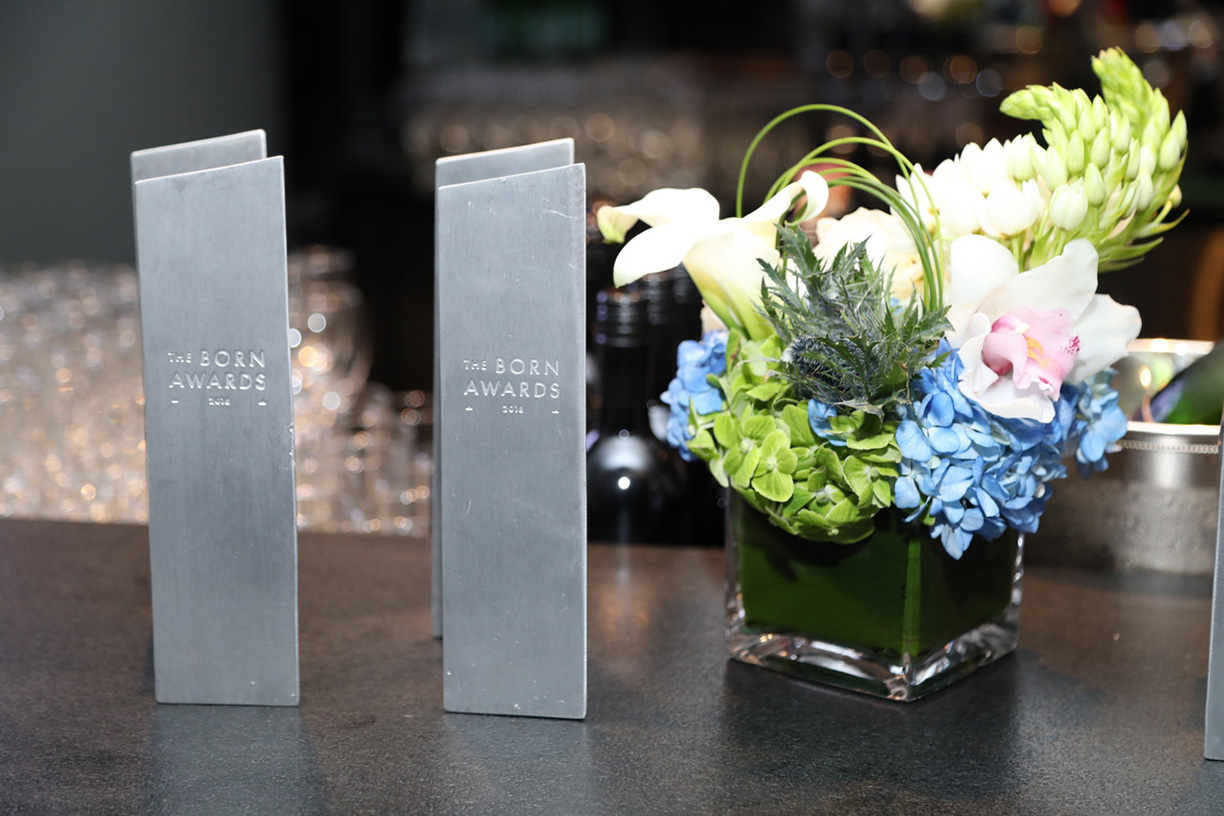
The 2018 BORN Award Winners are:
Architecture & Design: Jacques Garcia and Sydell Group, NoMad Hotel, Los Angeles
Technology & Innovation: Scott Painter, CEO & Founder, Fair.com
Home: Noah Kaplan, Lena Sound Sculpture by LEON Speakers
Sports: RabbitsFoot Surfboard, Ryan Lovelace based on an original idea by Dan Malloy
Leisure: Ryan & Adam Goldston, Athletic Propulsion Labs
Mobility: Stuart Parr,, MV AUGUSTA
Tastemade Prize For Food + Design: Jeni Britton Bauer, Jeni’s Splendid Ice Creams
Machinima Prize For Immersive Storytelling + Narrative Design In Gaming: Guerrilla Games, Horizon Zero Dawn
Photos courtesy of EM50 Communications
A percentage of revenue from The Chef’s Table at BLACKBARN restaurant will go toward the Heavenly Harvest Foundation, a charity that creates nutritious and quality meals for those in need.
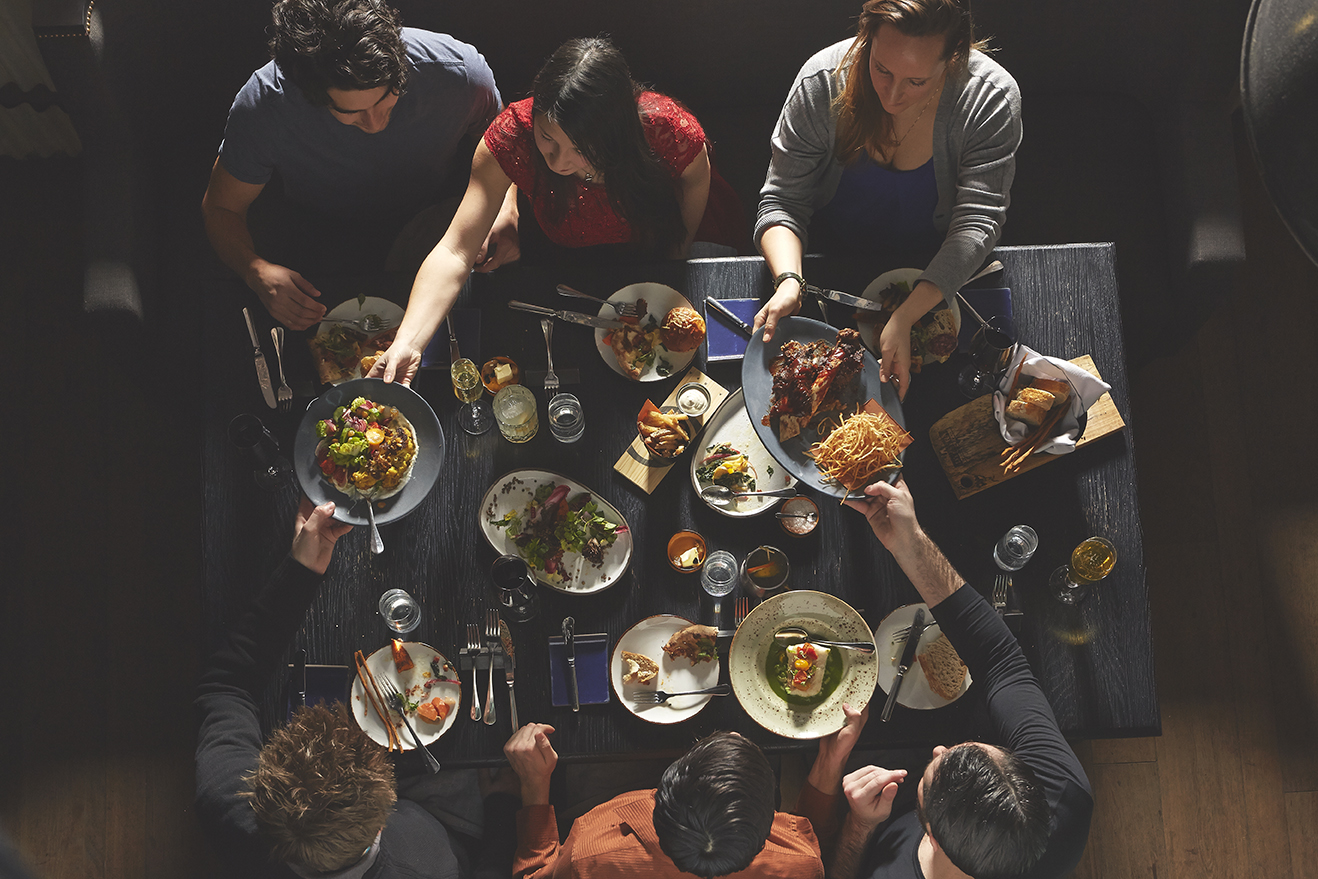
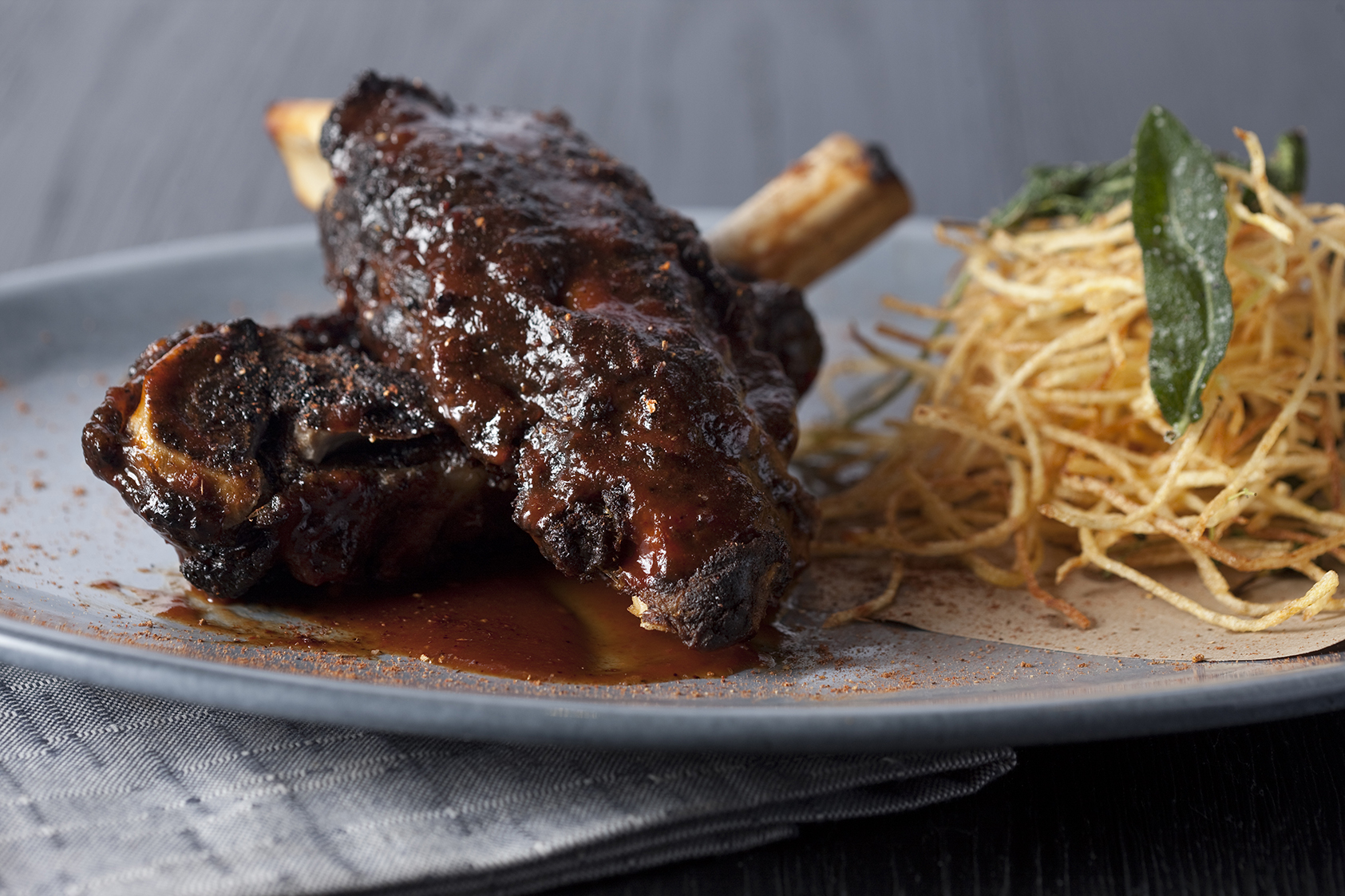
The Chef’s Table, open to the general public on Saturday nights, provides the opportunity to watch the restaurant’s renowned chef-owner John Doherty and his team in action and taste five distinct courses made from the season’s freshest ingredients. With a specially crafted menu that changes monthly, the $150 meal includes a selection of five wine pairings to present an affordable journey into New York City’s dining scene.
“We are thrilled to turn an evening out into an opportunity to give back for our guests, as proceeds from each dinner can provide a child in need with nutritious meals for an entire week,” says Chef John Doherty. “Like every detail of the BLACKBARN experience, from the decor to the tableware, the fully curated dinner leaves an impression of comfort and luxury while now sharing our passion for philanthropy.”
A personal dining experience that invites guests to have a front-row view of the action at long tables overseeing the exposed kitchen, The Chef’s Table offers a performance that is as elegantly simple as the dishes Chef Doherty creates. The April menu featured flavorful and unique combinations like a rich and round foie gras terrine cut with a tangy rhubarb and ginger conserve, and seasonal stars like ramps, white asparagus, fennel, and figs.
Some designer labels have successfully expanded their style to include branded restaurants.
By Samantha Myers
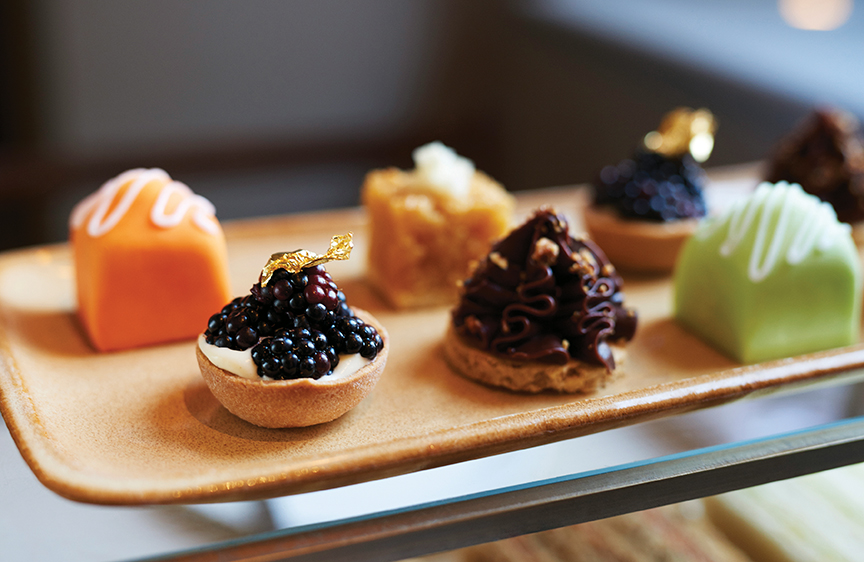
Photo courtesy Burberry
In recent years, high-end fashion houses have begun expanding their brands into fashionable food ventures, ranging from fine dining locales to cultivated cafes and refined bars.
One of the most notable fashion designers to establish contemporary food businesses as a direct extension of a signature brand is famed American designer Ralph Lauren. In 1999, Lauren opened his first restaurant, RL, adjacent to the world’s largest Polo store in Chicago. Similar to his fashion ideology, the restaurant focused on American classics — but traded in its collared Polo shirts, cashmere sweaters and neckties for steaks, seafood, chops and sandwiches.
RL, along with his subsequent restaurants, The Polo Bar in New York and Ralph’s on Boulevard Saint Germain in Paris, all have found ways to embody aspects of his iconic style.
Lauren’s newest venture is Ralph’s Coffee & Bar in London, located just next door to his flagship European store — a space that spans over 3 floors of product — on the iconic shopping stretch of Regent Street. The club-like atmosphere offers a decor that fits the designer’s equestrian aesthetic, and utilizes materials such as leather, brass and dark wood paneling.
“Ralph’s Coffee & Bar is a natural extension of the heritage of Polo and will add yet another dimension to the worlds we create,” said Lauren of the bar’s opening in January 2017. “I’ve always imagined our stores as a place for customers to experience a world. [This location] will add to that experience by offering a warm, friendly place to sit cozily with friends and family to sip a cup of our distinctive coffee or toast a special moment with one of our unique cocktails.”
Ralph’s Coffee & Bar
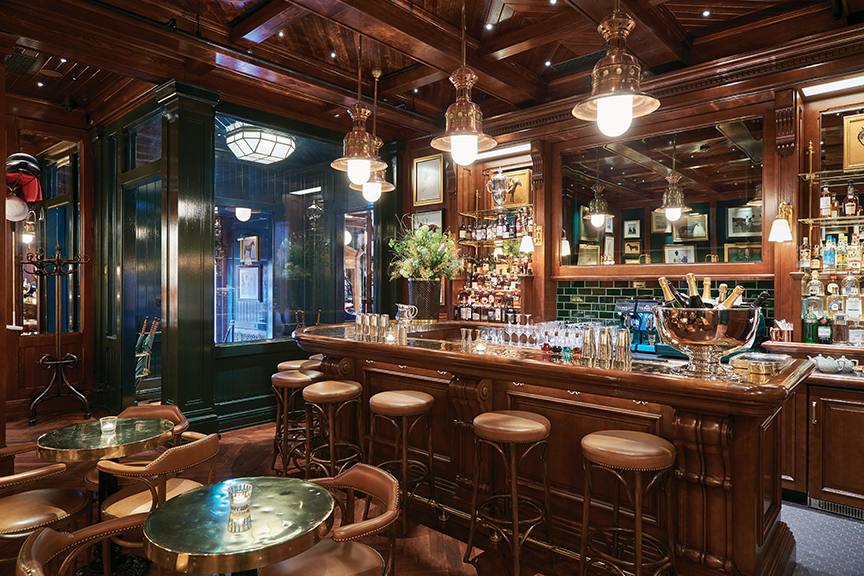
Photo courtesy Ralph Lauren
173 Regent Street
Mayfair, London W1B 4JQ
+44.(0)20.7113.7450
Jonathan Hatchman, food editor for The London Economic, believes Ralph’s Coffee & Bar meets its intent and holds up the Ralph Lauren image. “The bar completely epitomizes everything expected from Ralph Lauren: from the equestrian and polo themed accents, brass-topped bar, saddle leather seats and a palette of rich browns and bottle green,” he says.
While the menu follows suit with American classics, it has also embraced European elements. The bar sells three signature cocktails specifically created for the London location: Regent Street Sour, Ralph’s Winter Punch and Ralph’s Evening Roast.
During his visit, Hatchman indulged in the bar’s beverages and complementary snacks — especially the “ludicrously delicious” breaded and deep-fried olives. “I particularly enjoyed ‘The Chairman’ — a rye whiskey cocktail with an absinthe rinse, both typical Sazerac components and one of my favorite cocktails,” he says. “The bar’s take on an ‘Old Fashioned’ was good, too, served in a huge polo-etched glass, made with woody Eagle Rare bourbon.”
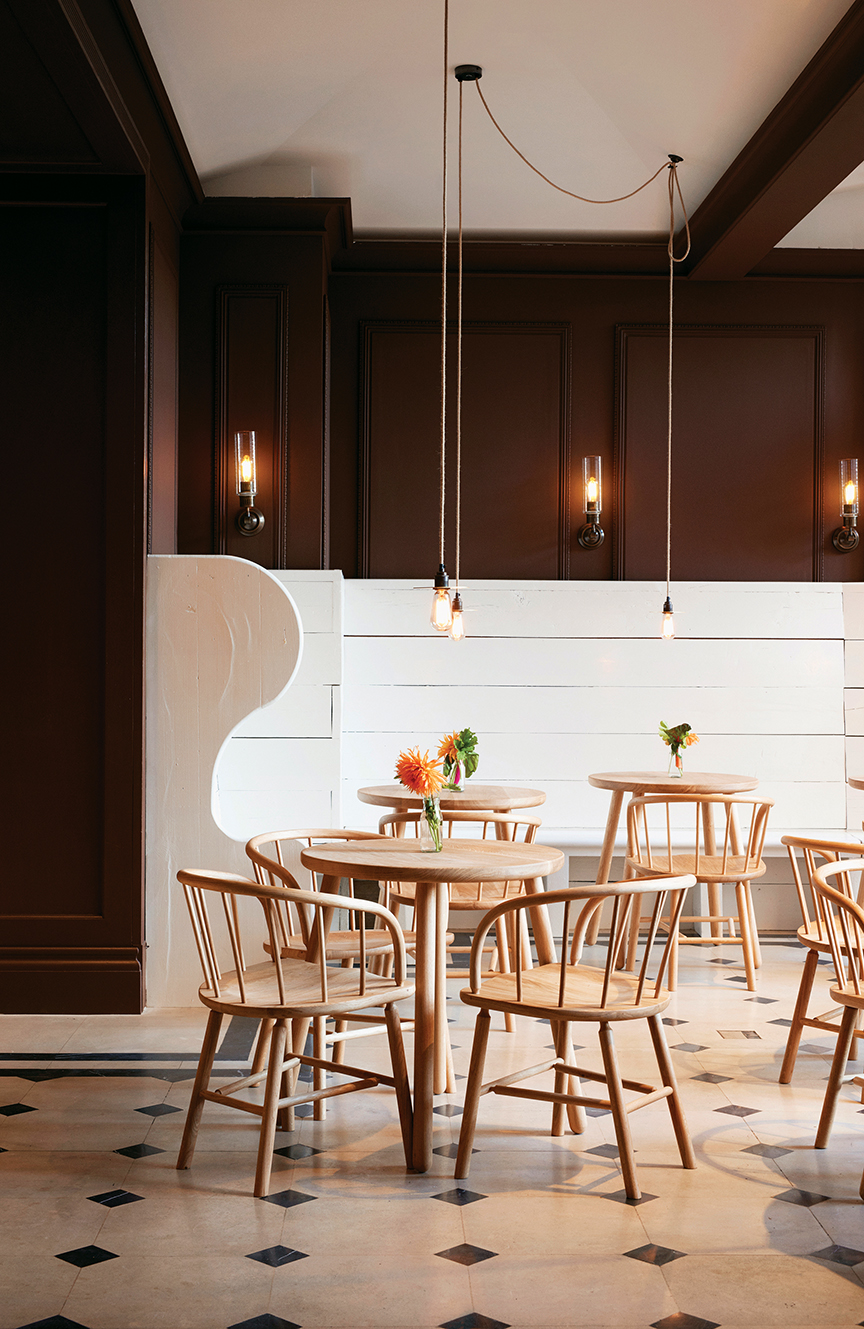
Photo courtesy Burberry
Thomas’s at Burberry Regent Street
5 Vigo Street
London W1S 3HA
+44.(0)20.3159.1410
A few minutes down Regent Street, another famed fashion brand has quite literally broadened its label into a culinary eatery. Known for its iconic trench coats and classic trademark tartan plaid, British luxury fashion house Burberry is also giving its clientele an equally posh spot to dine as their clothes have given them to wear.
Named for its founder, Thomas Burberry, Thomas’s is described as an “all-day dining destination” within the company’s flagship London store. This particular location offers a special gift area, as well as in-store monogramming services so that leather accessories and luxury goods can be embellished with one’s initials.
With a menu ranging from lobster to finger sandwiches and English cakes, Thomas’s is a sophisticated cafe for both a shopping break or a social meal. What’s better than concluding a Burberry shopping spree with a fine cup of tea and a locally sourced lunch?
“All of the produce is sourced from British small farms and artisan suppliers, while the decor is quite simple with marble-topped tables, dark-wood chairs and plenty of natural light that floods the room,” says Hatchman. “Inside, the cafe is, essentially, a continuation of the store, with friendly, unthreatened service, as expected from a high-end retail space.”
“Thomas’s is very much an extension of the store,” says Hatchman. “It would appeal most to central London shoppers — either customers of Burberry, or surrounding Regent Street shops.”
Hatchman visited the store-cafe for Breakfast at Burberry. “For me, the quality of carefully selected produce really stood out,” he says. “In terms of food, the full English breakfast is a million miles from the greasy spoon classic, but it’s a fair, refined version that doesn’t skimp on quality or on the meat. I remember the black pudding being particularly delicious.”
Yet, aside from the cafe’s quite literal connection with its store, the restaurant refrained from becoming a physical manifestation of its iconic Burberry clothes. “Thomas’s is very much an extension of the store,” says Hatchman. “It would appeal most to central London shoppers — either customers of Burberry, or surrounding Regent Street shops.”
Rather than extend its brand, Burberry has extended its store’s space into the realm of nourishment. “I wouldn’t say that the cafe is a complete embodiment of the brand’s style,” he says. “But — like Burberry — the cafe is staunchly British and proud.”
www.JonathanHatchman.com
info@JonathanHatchman.com
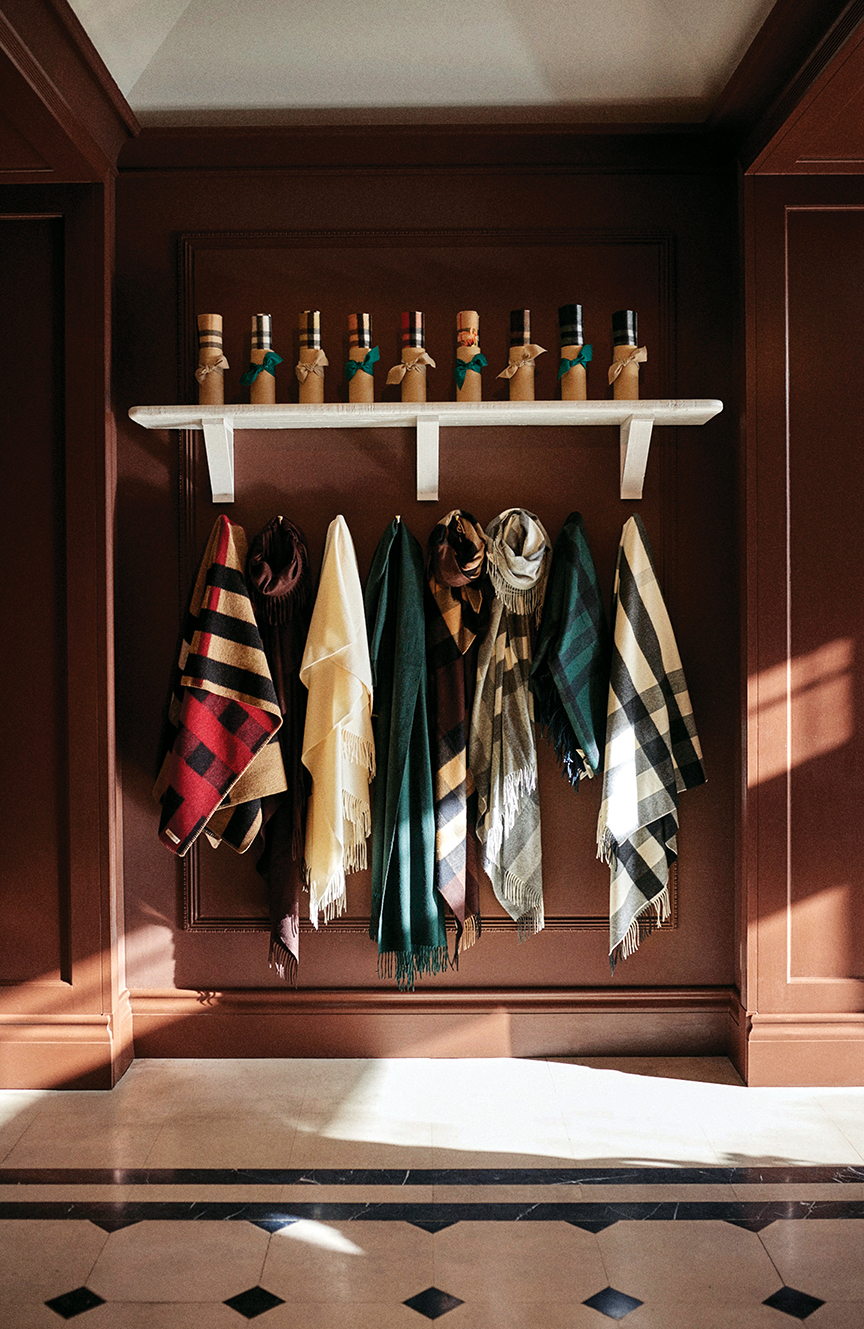
Photo courtesy Burberry
Armani / Ristorante 5th Avenue
While Ralph Lauren and Burberry have effectively incorporated restaurants into their brand’s empire, others have been unsuccessful, with their restaurants disappearing quickly after the initial buzz diminished. Take Marc Jacobs Café in Milan or Cavalli Miami Restaurant & Lounge.
Armani, however, has not had a problem.
Across the sea, immersed in the heart of Manhattan overlooking New York’s own shopping stretch — 5th Avenue — is Armani/Ristorante, one of the slew of restaurants bearing the name of the Italian mega-designer. You don’t have to travel far to find a Giorgio Armani restaurant venture — Armani Restaurants have been steadily popping up across the Americas, Europe and Asia for years, and now have over a dozen locations.
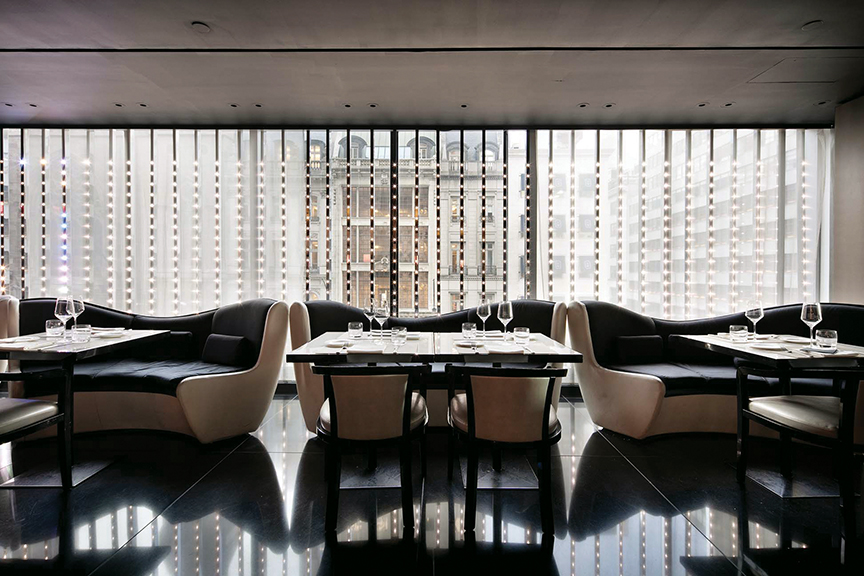
Photo courtesy Giorgio Armani
717 5th Avenue
3rd Floor
New York, NY 10175
212.207.1902
This particular Armani restaurant can be found on the third level of the Armani/5th Avenue store. Designed by Fuksas, the heart of the building is the sculptural steel staircase that leads customers to and from Armani-curated shopping and dining. The restaurant incorporates an Italian-inspired trendy style through a commanding backdrop of black and white, sleek curves and straight lines and furbished LED lights that give it the edge it needs.
Armani/Ristorante is structured in true Italian fashion — antipasti, primi piatti, secondi, and also offers breakfast and lunch, most likely for visitors to its bustling store.
Although epitomizing Armani’s sleek, hard-edged style, Armani restaurants are beyond a re-creation of his style in restaurant format. In fact, his locations have bolstered into culinary expeditions and have seen partnerships with some of the world’s top chefs, such as Milan’s Armani/Nobu, where he created a restaurant with celebrity chef Nobu Matsuhisa. The polished restaurant is unmistakably Armani, yet has a warm Japanese influence in both the design details and of course, the food.
American chefs appreciate French tradition, but are increasingly inspired by ethnic communities in their own backyards.
By Roger Grody
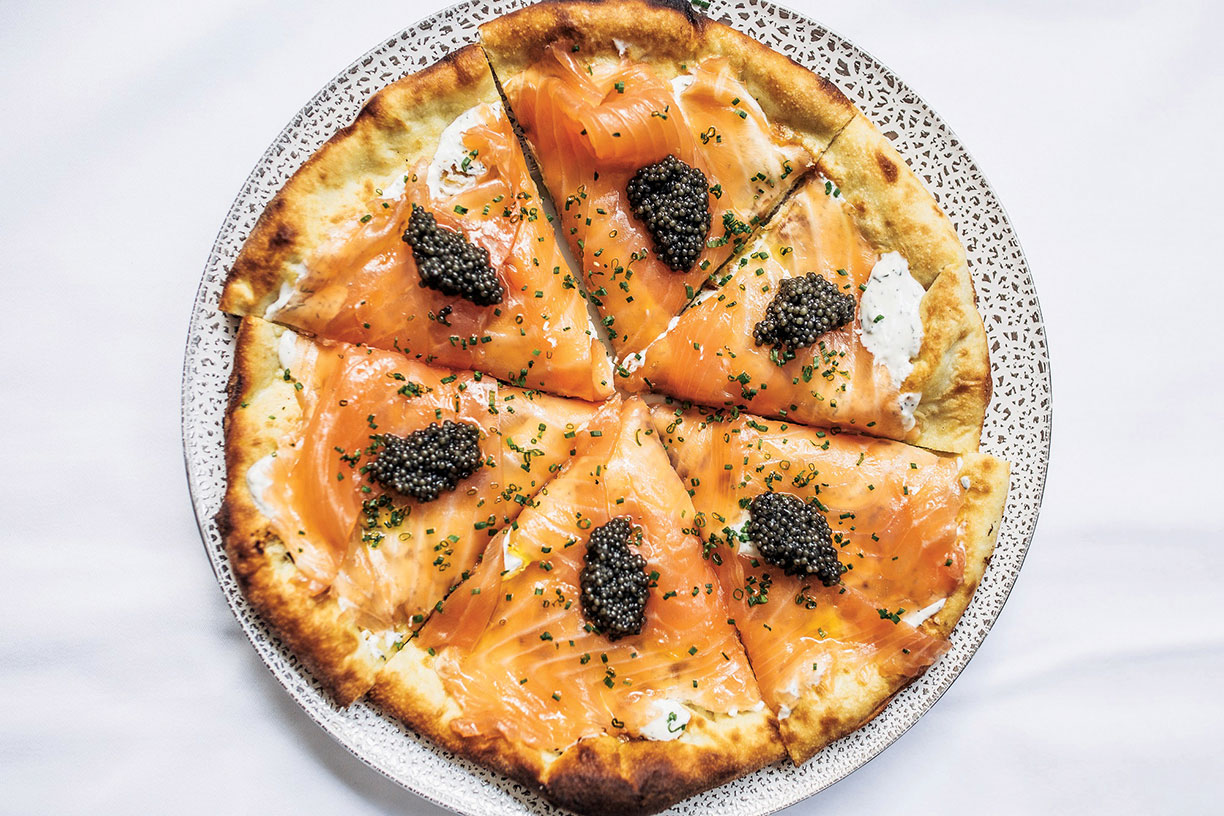
Photo courtesy Antonio Diaz
There was a time when young chefs in America were primarily influenced by French masters like Paul Bocuse or Joël Robuchon. While classic technique remains important, eclectic global flavors have become equally influential. Conveniently, chefs no longer need to travel the world to discover exotic fare, because it is simmering in the diverse ethnic neighborhoods of most American cities.
The practice of incorporating ethnic elements into familiar dishes used to be referred to as “fusion,” a term that has fallen out of favor with contemporary chefs, and today’s cross-cultural combinations are more nuanced and less frivolous than in the 1980s. Today, chefs tend to use local ethnic cuisines as accents or pay tribute to their own families’ immigrant roots. The presence of Middle Eastern falafel on a French menu or a dusting of Japanese togarashi seasoning on potatoes at an all-American steakhouse does not compromise the integrity of their respective cuisines, but certainly makes them more interesting.
A master of infusing local ethnic flavors into his dishes is celebrity chef José Andrés, who borrows Latin American and Asian elements at The Bazaar by José Andrés in Los Angeles. In multicultural Miami, he incorporates Caribbean elements into his menu at The Bazaar South Beach. Given his own Spanish heritage, incredible versatility and expertise with complex molecular gastronomy techniques, most Andrés menus feature some unusual culinary mashups.
At South Beach, Andrés honors the local Cuban community with colada Cubana, a play on Cuban coffee turbocharged with foie gras, and pollo al ajillo (garlic chicken) slow-cooked with black garlic. As a tribute to South Florida’s Jewish community — largely comprised of transplanted New Yorkers — the chef offers a clever riff on bagels and lox: dill cream cheese-filled bagel cones topped with salmon roe. And for dessert, Andrés playfully deconstructs another local specialty, Key lime pie.
Bazaar South Beach chef de cuisine Tito Vargas, a native of Puerto Rico, says he and Andrés draw inspiration from a wide variety of Latin American and Caribbean cultures. “It’s important that I keep true to José’s vision, showcasing the main ingredient and transforming it without sacrificing the flavor and integrity of the product,” he says. Vargas notes that even when applying high-tech culinary tricks, the essence of a dish is respected and preserved. “In no way, shape or form does it look like a Cuban sandwich, but when you bite into it you get all the flavors that compose a Cuban sandwich in a more fun, inventive way,” says the chef of The Bazaar’s molecular gastronomic version.
Despite Los Angeles’ reputation as a bland, immense swath of suburbia, its location — on both the Pacific Rim and threshold to Latin America — ensures diverse ethnic communities that constantly fuel the imagination of local chefs. In L.A., where California Cuisine has morphed into a more global fare, crossing culinary borders is almost routine. At Wolfgang Puck’s celebrity-favored Spago in Beverly Hills, for instance, the menu includes elements from nearly a dozen cuisines.
Bryant Ng was trained in classic French cuisine — he cooked with celebrated chef Daniel Boulud in New York — but at his own restaurant, Cassia in Santa Monica, California, he cooks French brasserie fare with an ethnic twist. At first glance, Cassia’s menu looks like it was borrowed from a Parisian brasserie, but the young chef tweaks traditional dishes with accents from his father’s Singaporean roots and his wife’s Vietnamese heritage.
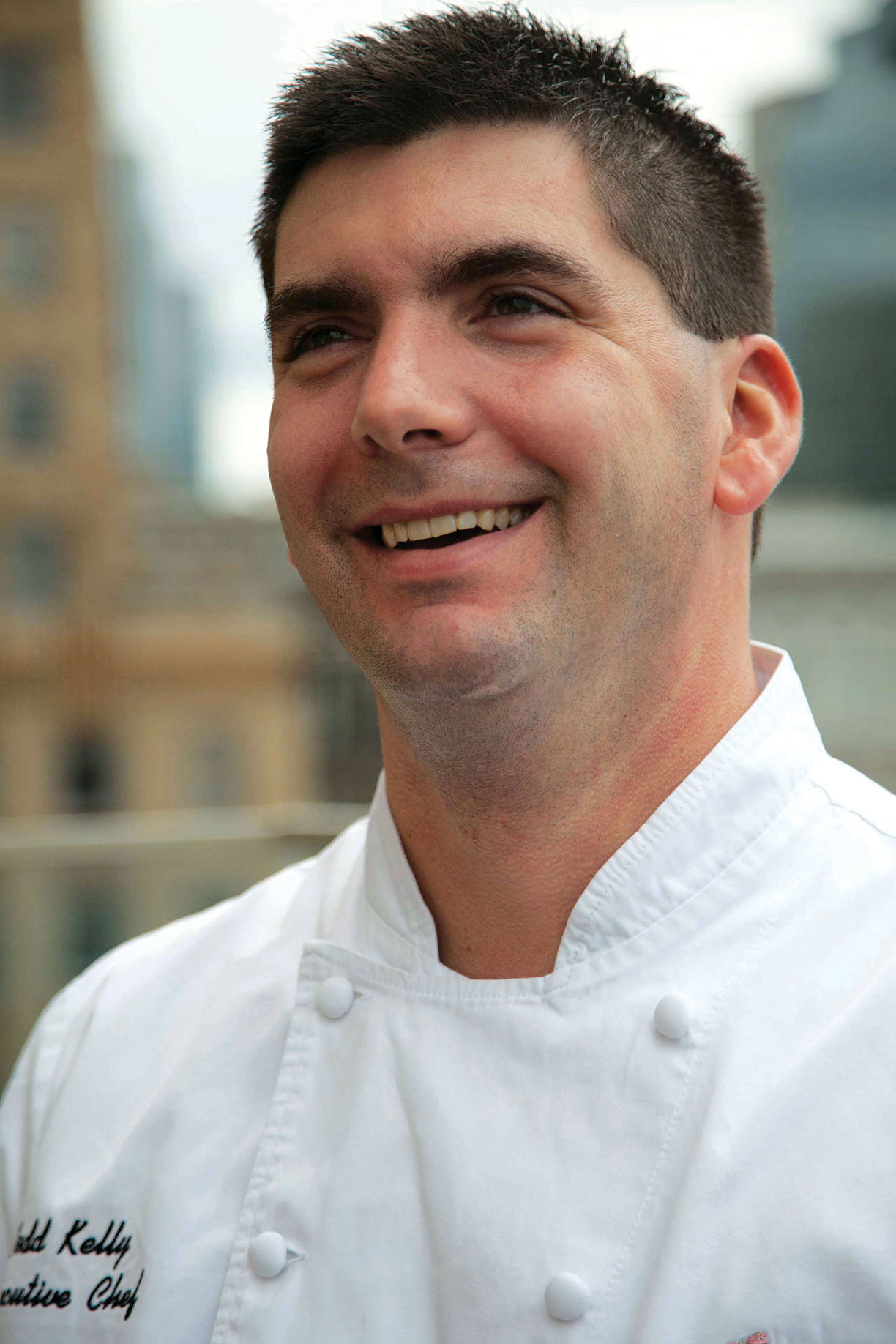
Todd Kelly
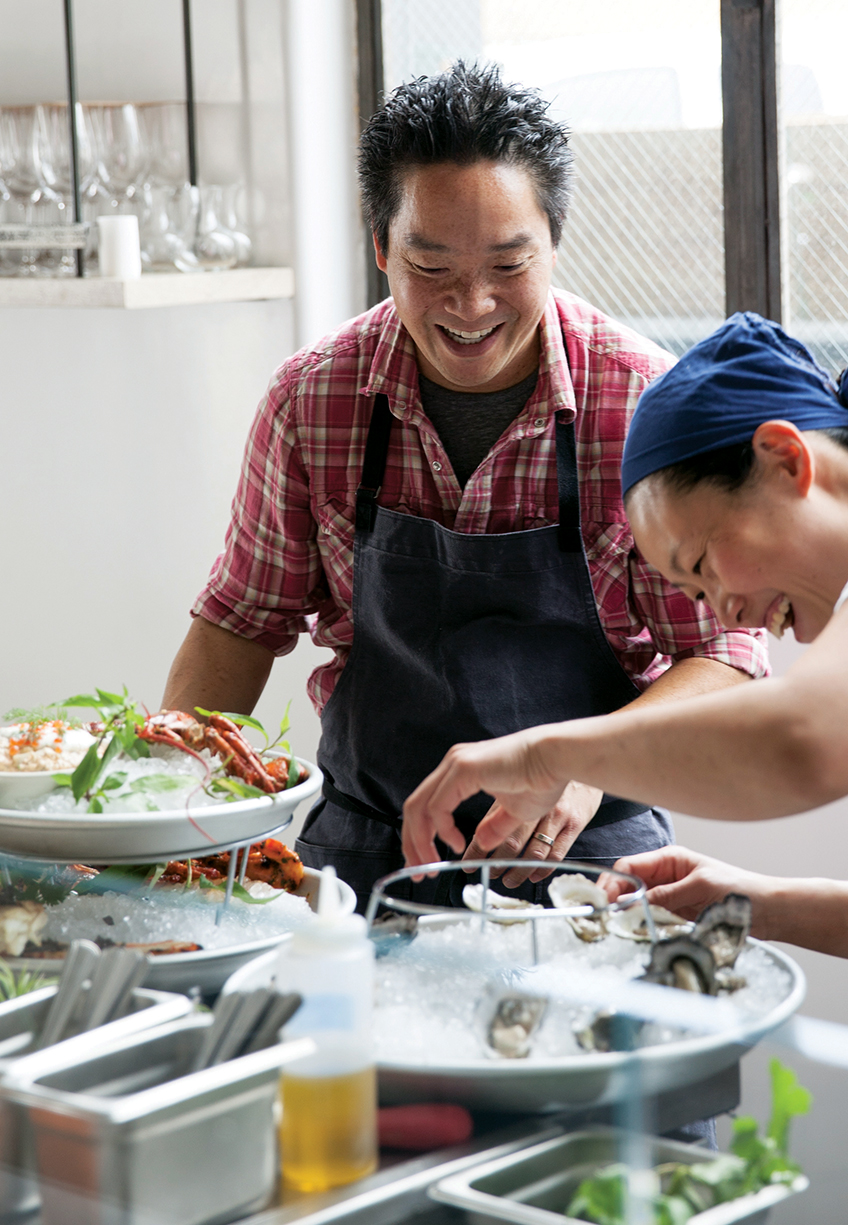
Bryant Nig
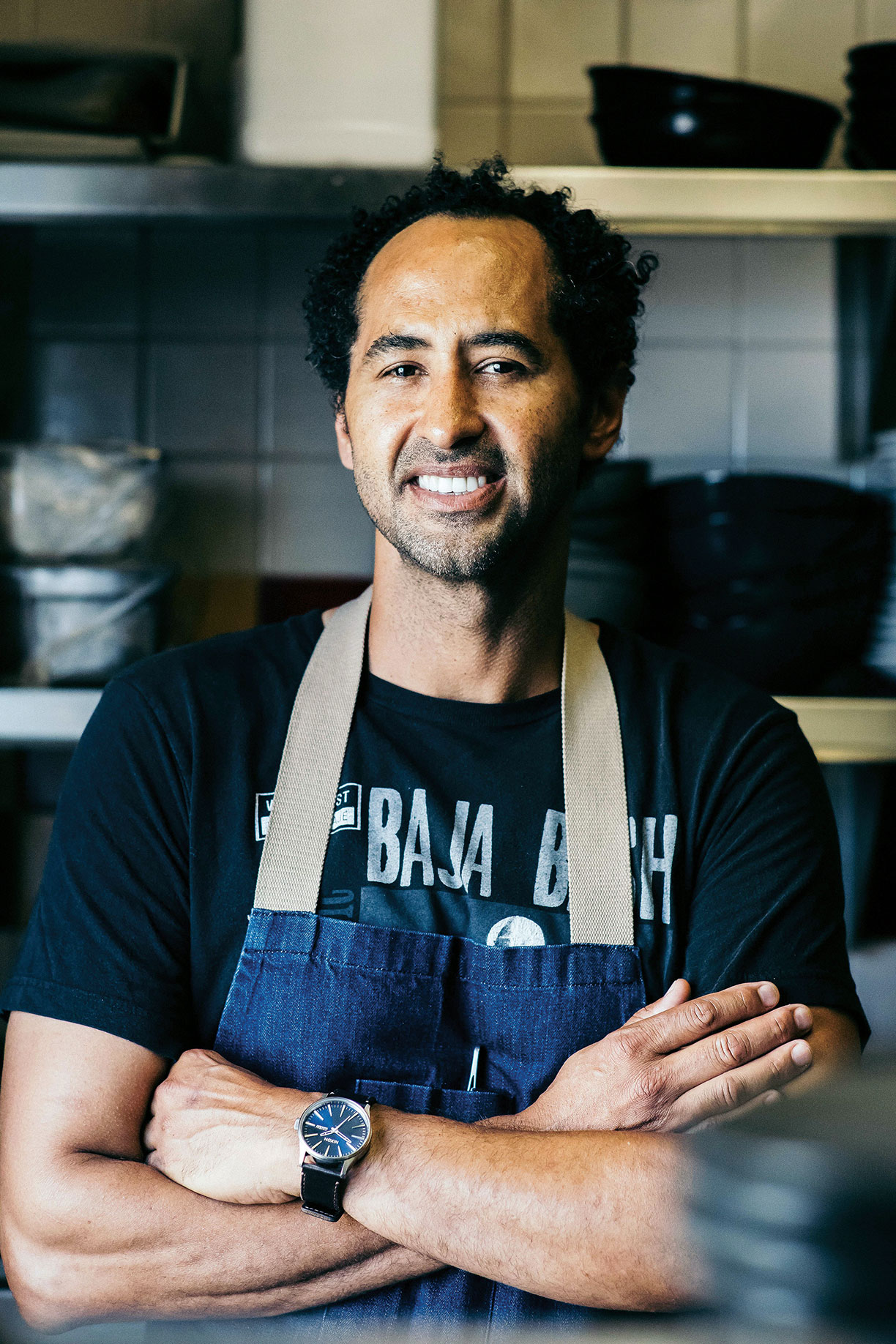
Jason Nibb
Ng’s charcuterie platter includes items like Singaporean candied pork and Vietnamese meatloaf, while escargots are scented with lemongrass. Cassia’s take on the French comfort dish of pot-au-feu has a pho-inspired broth and the bistro staple of steak frites is bathed in a Phú Quôc Island peppercorn sauce. Kaya toast, a signature of Singapore’s street vendors, is not likely to be found in a 14th arrondissement brasserie, but is a specialty at Cassia.
“It’s a very personal menu because it combines the food of my heritage, but also has influences from my professional experiences,” explains Ng. “Understanding the ‘soul’ of a cuisine is the greatest challenge,” says the chef, who dismisses the practice of simply adding a single indigenous ingredient. “Trying to incorporate multiple culinary influences requires a lot of self-editing and discipline,” adds Ng, who believes any composition must respect the referenced cultures.
Anita Lo is one of New York’s most honored chefs and her restaurant Annisa is a reflection of the diverse influences inherent in contemporary American cuisine. A second-generation Chinese-American, Lo’s passion for food can be traced to Paris, where she first fell in love with the art of cooking. She polished her skills in revered French kitchens and classic technique has always been essential to her approach.
At her Manhattan restaurant, those French sensibilities are applied to some ingredients from her own family’s heritage, as well as other global influences discovered in New York’s rich patchwork of ethnic neighborhoods. Since Annisa’s opening in 2000, Chinese dumplings filled with foie gras mousse and jicama have been one of Lo’s signature dishes. A Chinese-French mashup way too cool to be called “fusion,” the dumplings are topped with seared foie gras and a beguiling black vinegar reduction.
At Orchids at Palm Court, an opulent dining room in the Art Deco Hilton Cincinnati Netherland Plaza, executive chef Todd Kelly is contributing to getting the food scene of the Midwest — a region often neglected outside of Chicago — noticed. As a boy, the native New Yorker lived in Mauritius, an island in the Indian Ocean near Madagascar, and that experience, as well as the chef’s naturally curious palate, results in a menu with eclectic influences.
Kelly’s cuisine, built on a solid classical foundation, is laced with intriguing ingredients like Buddha’s hand, lemongrass, paneer, and sudachi. He is adept at making familiar preparations suddenly exciting without excessively altering their essence. For example, a dash of harissa (a spicy North African chili paste) gives a dish of white asparagus with traditional French velouté sauce some zing, while red snapper en papillote, a characteristically South of France preparation, receives an exotic Indian accent with vadouvan curry.
“I like to pull in flavors from my past or things I really crave,” says Kelly, noting that the cultural melting pot of Mauritius and ethnic neighbors on Long Island both contributed to his culinary wanderlust. Recently, the chef has been experimenting with Indian ingredients like nigella, fenugreek and mango powder, insisting they need not distract from the classical roots of a recipe. “The lesson is all about balance and learning that sometimes it’s the simplicity and restraint that controls a dish,” says Kelly.
In La Jolla, San Diego’s chic oceanfront district, executive chef Jason Knibb is known for his molecular gastronomy and globetrotting flavors at Nine-Ten Restaurant & Bar, which celebrates the Golden State’s finest seasonal ingredients. His Jamaican heritage may account for the jerk-seasoned pork belly on the chef’s menu, but his ethnic influences also extend to Latin American, Japanese and Middle Eastern traditions.
“San Diego is a tapestry of rich ethnic diversity, and the local food scene is no exception,” says Knibb. “There are so many chefs who have come to town from other regions bringing their own ethnic influences,” he adds, and makes a point to experience their cuisines firsthand. As a young chef in San Francisco, Knibb lived next door to a quick-service Mediterranean restaurant, and says, “They had some of the best falafels I’ve ever had … I still crave them today.” That unpretentious Mission District eatery was the inspiration for Nine-Ten’s spice-roasted carrots and carrot falafel with harissa yogurt and carrot hummus.
The recently announced James Beard Awards — the Oscars of the restaurant business — reflect a renewed respect for ethnic inspirations. The big winners were Israeli-American chef Michael Solomonov of Philadelphia’s Zahav and Chicago’s Topolobampo, where celebrity chef/restaurateur Rick Bayless is energized by his frequent travels to Mexico.
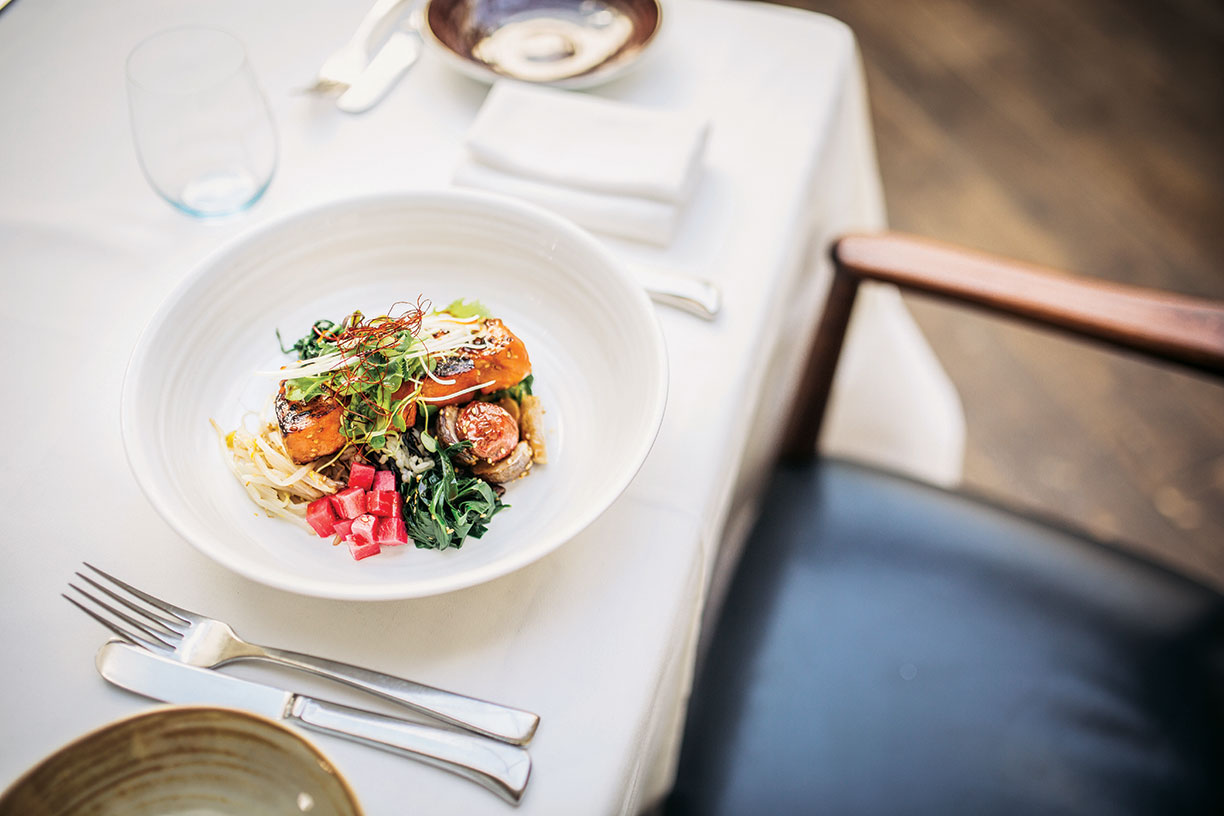
Photo courtesy Antonio Diaz
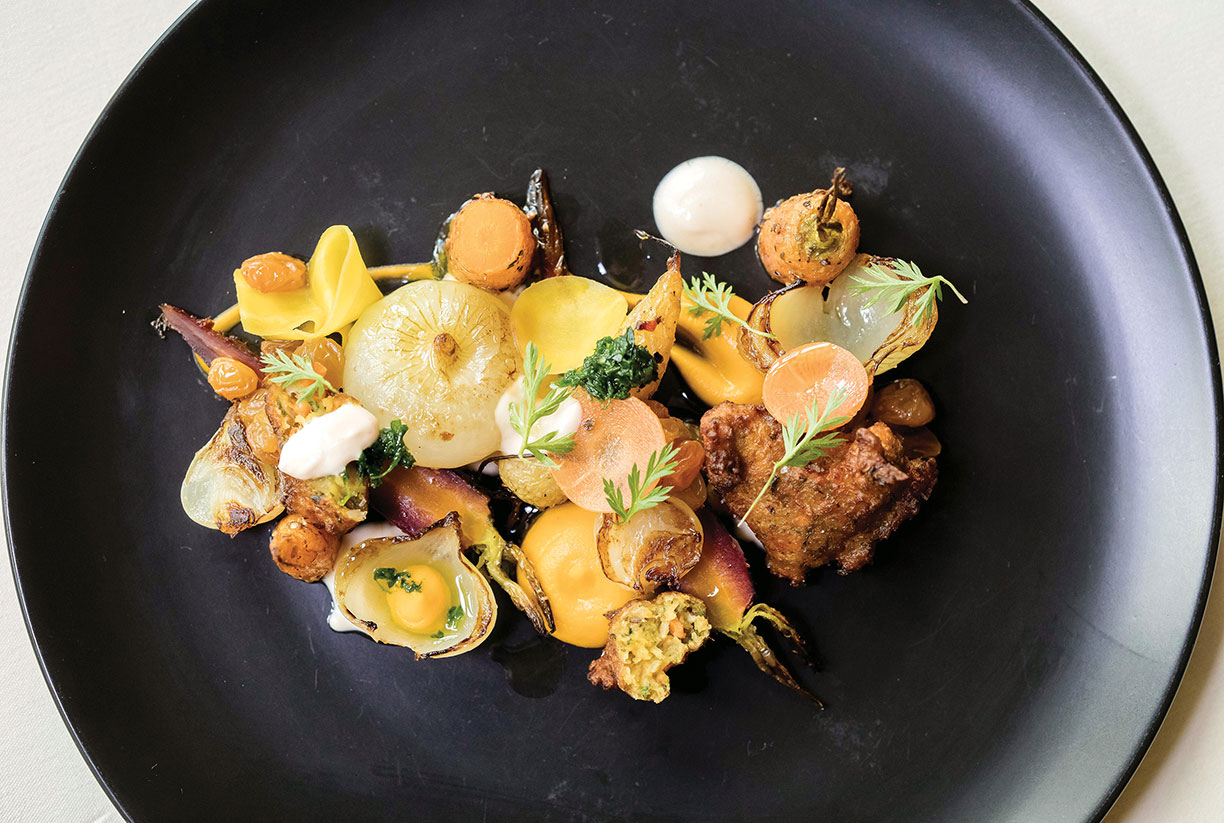
Photo courtesy Jason Knibb
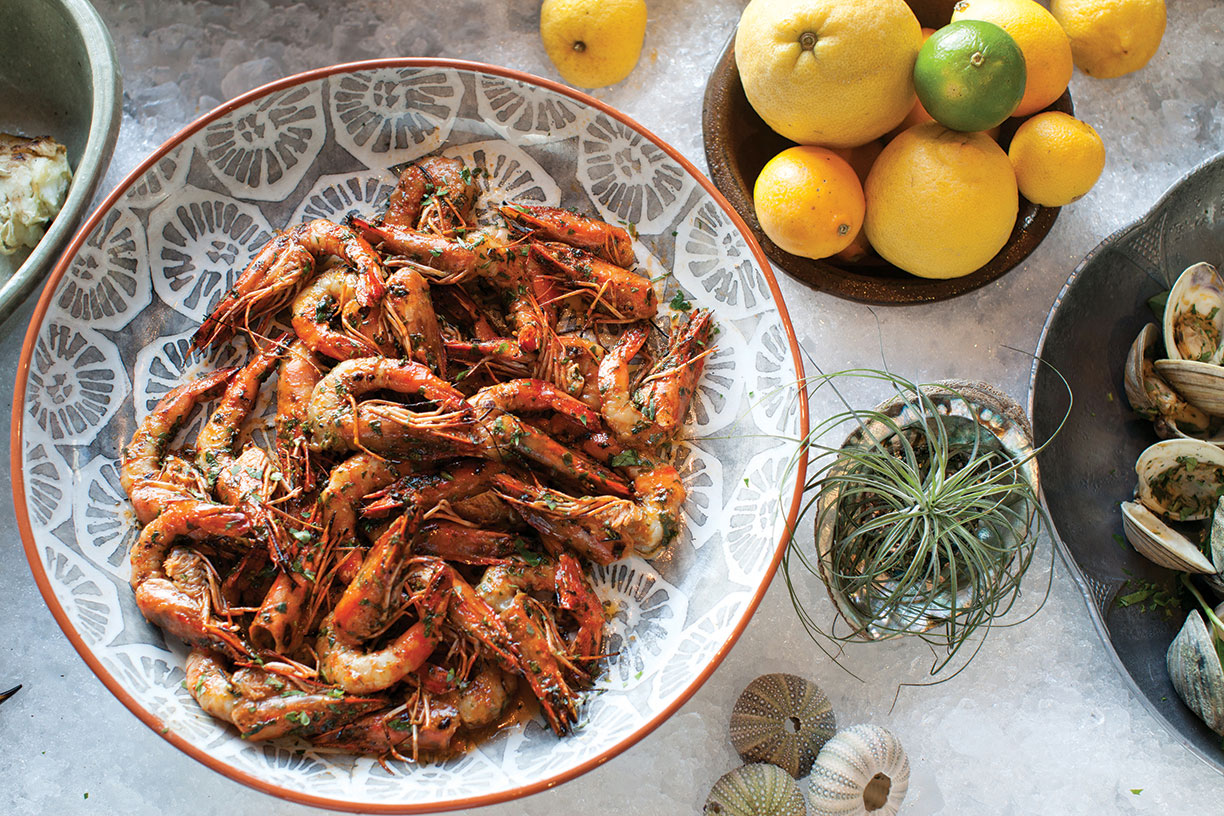
Photo courtesy Rick Poon
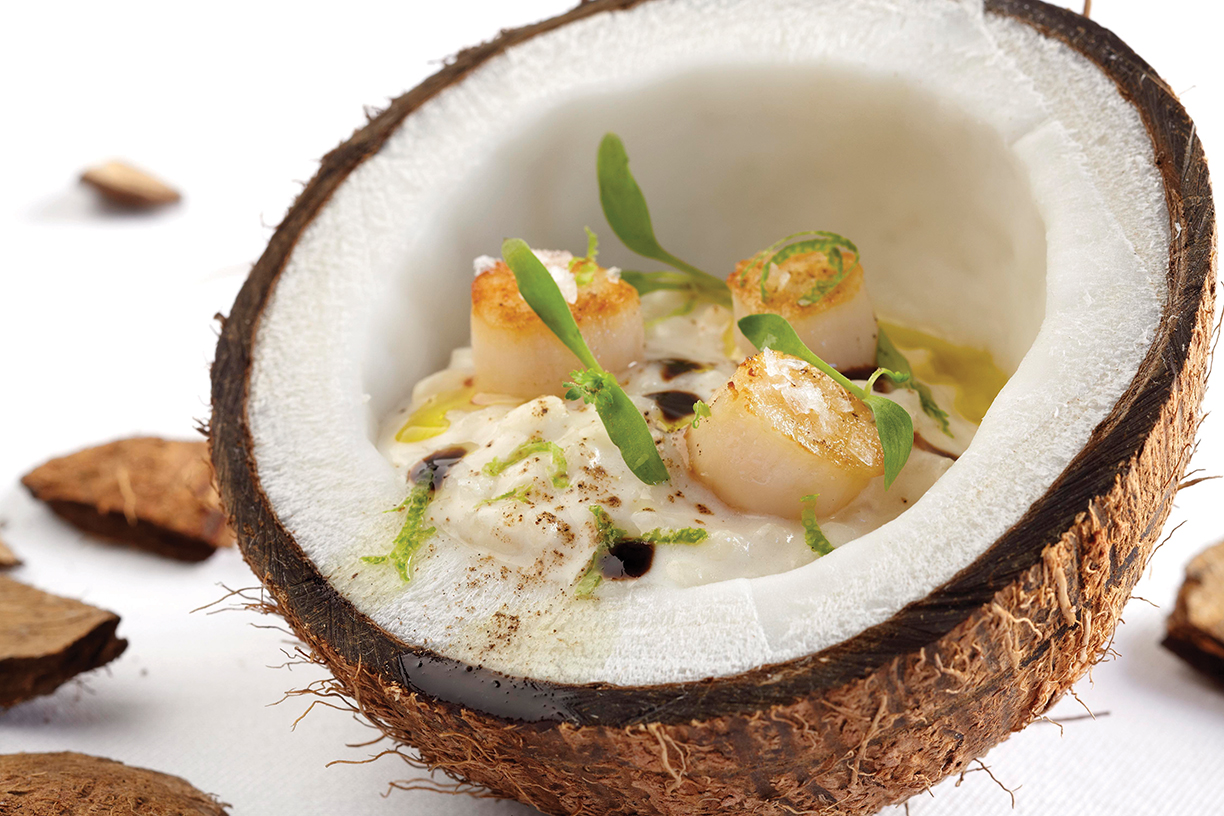
Photo courtesy Greg Powers Photography
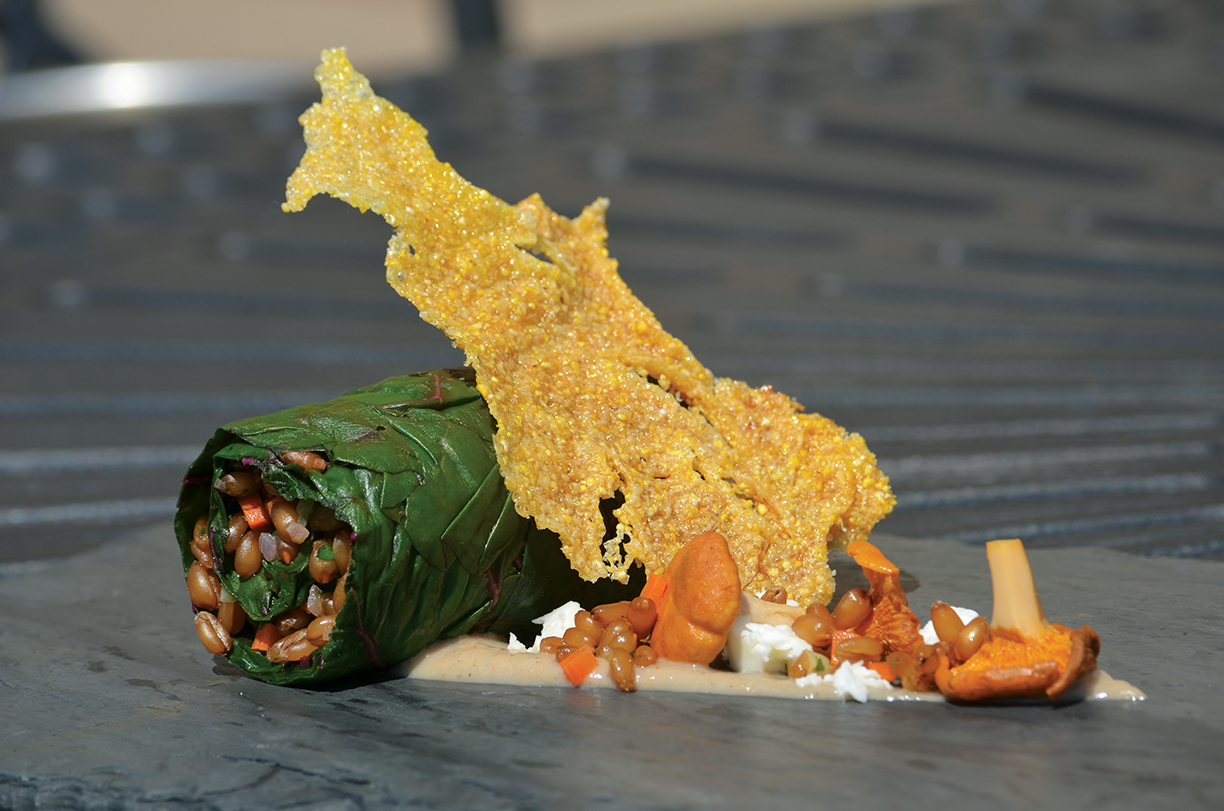
Photo courtesy Todd Kelly
Global Influences
Annisa, New York; www.annisarestaurant.com
The Bazaar by José Andrés, Los Angeles; www.sbe.com
The Bazaar by José Andrés South Beach; www.sbe.com
Cassia, Santa Monica; www.cassiala.com
Orchids at the Palm Court, Cincinnati; www.orchidsatpalmcourt.com
Nine-Ten Restaurant & Bar, San Diego; www.nine-ten.com
Spago, Beverly Hills; www.wolfgangpuck.com
Topolobambpo, Chicago; www.rickbayless.com
Zahav, Philadelphia; www.zahavrestaurant.com
While farm-to-table produce was once a hot trend, community residents have now begun to expect farm fresh ingredients on their plates and in their cocktails.
By Alyssa Gautieri
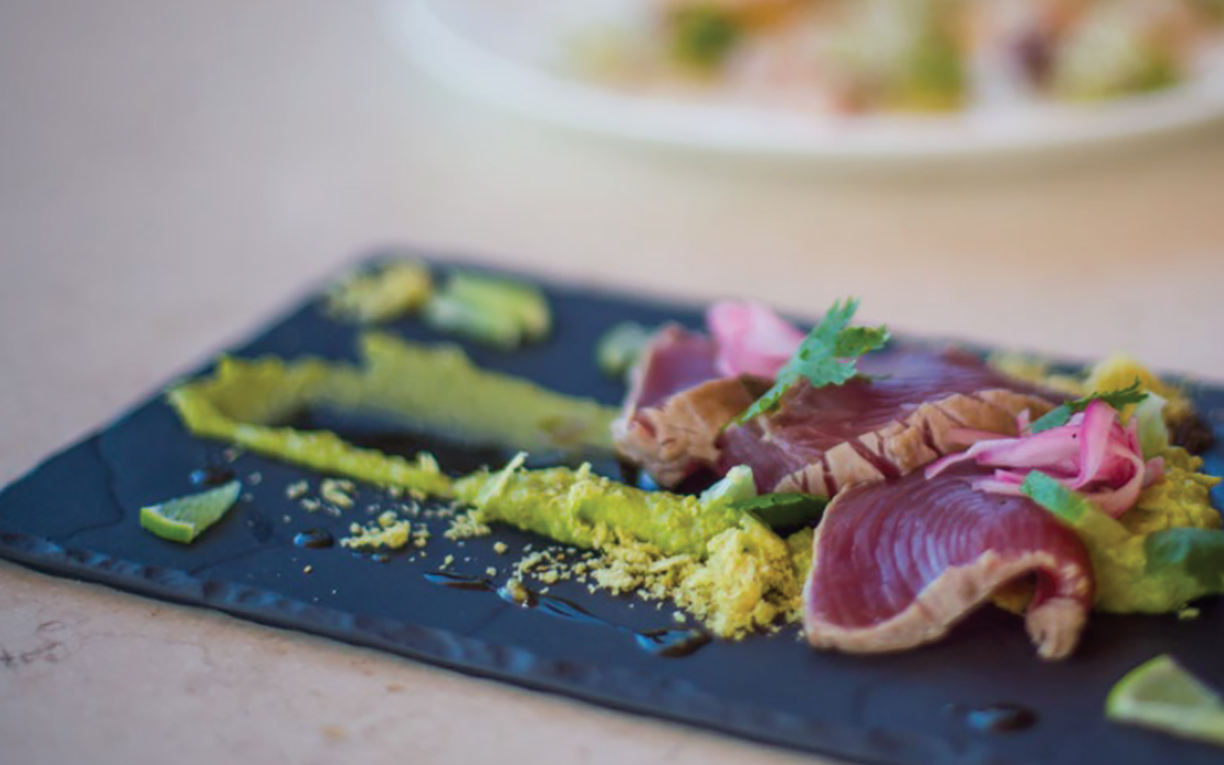
To keep residents and guests happy, residences and resorts have embraced the farm-to-table movement, but they have also begun to take the culinary experience a step further. These residences have expanded their on-site offerings to include organic farms, educational programs and more. These innovative ideas are bringing the authentic flavor of the land to restaurants, bars and homes.
Kukui’ula
This property offers an Upcountry Farm, a 50-acre community farm equipped with a staff of farmers who help residents and guests harvest seasonal fruits and vegetables. In addition to gardening lessons from farmers, residents can tend the soil, pick from fields of fruits and vegetables, taste seasonal produce or cultivate an appreciation for sowing, growing and harvesting. The community also offers a gourmet farmers’ market on Wednesdays and monthly farm-to-table dinners prepared by Chef Ben Takahashi.
Photos courtesy of KuKui’ula
The Cliffs Broken Oak Organic Farm
This community founded Broken Oak Organic Farm, a 5-acre farm complete with greenhouses and fields for year-round growing. The farm also uses organic growing practices. The Farm hosts a monthly farm stand, as well as “People to Farm” dinners, wine tastings and educational classes.
Photos courtesy of The Cliffs
Costa Palmas
This new development, which is set to open on the East Cape of Cabo in 2018, will feature the first Four Seasons in the area and will have 18 acres of orchards and farms. In addition to providing an amenity to residents, the organic farms will produce food for the hotel and create an opportunity for the inhabitants of La Ribera. Fresh tomatoes, bananas, papaya and chili peppers will appear in cocktails and meals, and the best avocados and limes in the world will compliment tasty dishes.
Photos courtesy of Costa Palmas
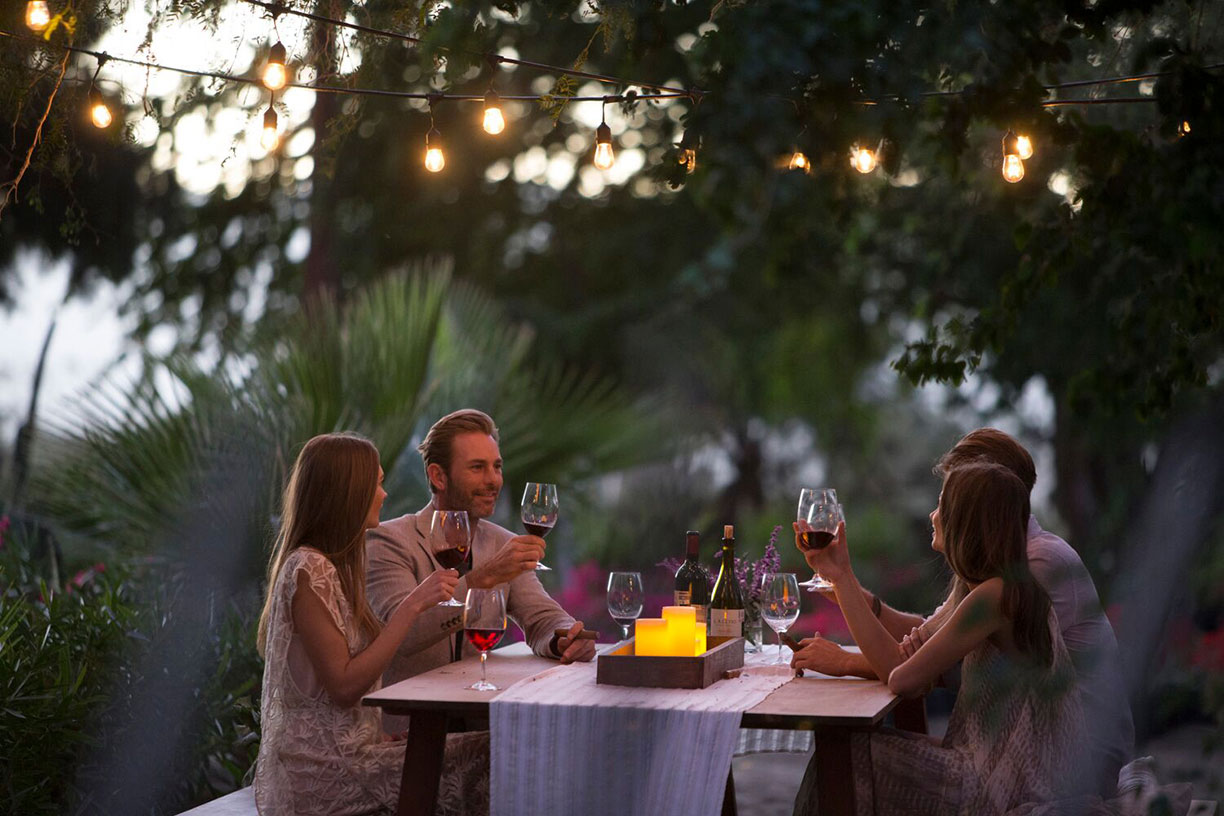



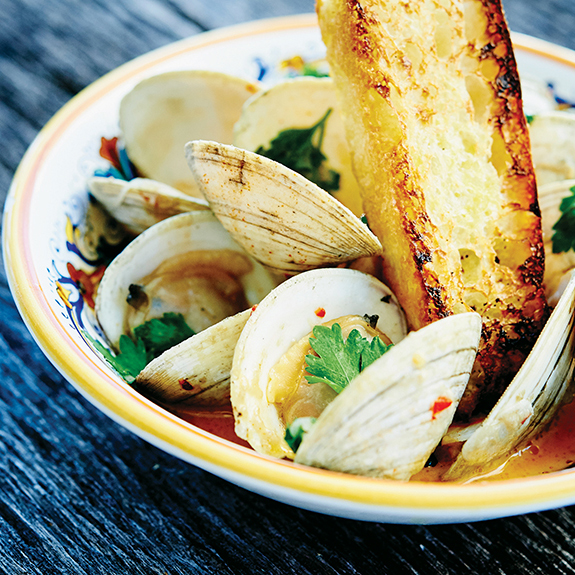
It may lack the culinary notoriety of San Francisco, New Orleans or the Big Apple, but St. Louis has quietly been developing a serious food scene. In addition to benefitting from a large Italian-American community and a geographic flirtation with the South, talented young chefs from around the country are arriving. Largely responsible for St. Louis’ dining renaissance is chef and prolific restaurateur Gerard Craft.
Craft, who grew up in Washington, D.C., opened his first restaurant in St. Louis knowing very little about the city except that it offered affordable space for a struggling 25-year-old chef. That restaurant, Niche, ignited the local dining scene and his Niche Food Group now operates five restaurants in the Gateway City.
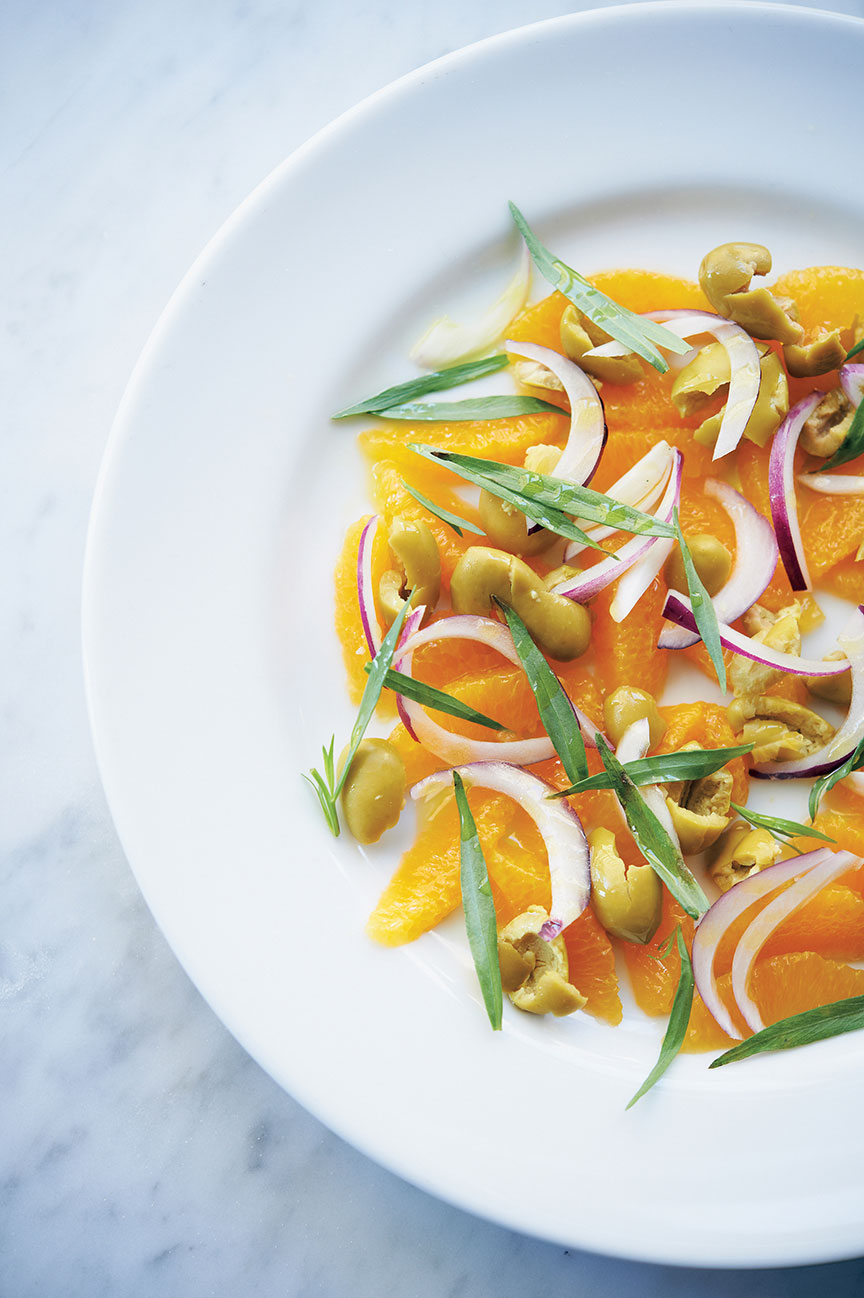
“I still wasn’t that interested in food, but fell in love with the kitchen’s energy, comradery and instant gratification. “I loved the idea that you could produce something, serve it and see the impact it has on people, then clean up and move on to the next day,” recalls the young cook. After spending some time in France, even enrolling in a work-study program at the Ritz in Paris, Craft was feeling confident enough to talk his way into a line cook position at Park City’s well-respected Bistro Toujours.
“It was a disaster,” reports Craft, explaining, “The chef sat me down and told me I had no skills and that I could either leave or work as a prep cook in the basement.” Now recognizing this as a turning point in his career, Craft says, “Being demoted was the best thing that ever happened to me. After I got some hands-on experience down in the basement, I was able to work my way through every station on the line.” After an apprenticeship at the upscale Ryland Inn in New Jersey, Craft earned a sous chef position at Chateau Marmont, a celebrity haunt on Los Angeles’ Sunset Strip.
Hearing that prominent chef Larry Forgione and some other talented chefs had opened restaurants in St. Louis, Craft flew there to look at an old wine bar for a potential restaurant of his own. “It had boarded-up windows, a dirt floor and no electricity,” recalls Craft, who took possession of the space in February 2005 and reopened it as Niche later that year.
Craft had little interest in cooking as a young boy, recalling, “My family was really into food, but I was probably the pickiest eater in the world.” Despite that self-characterization, Craft’s most meaningful food memories revolved around the cooking of his Brazilian nanny. “She was like a second mom to me, and I grew up eating simple, rustic Brazilian food like black beans and feijoada,” says Craft, who adds, “She had such a touch with food and was able to make anything taste great.” He honored that influential nanny by offering contemporary versions of pão de queijo (Brazilian cheese bread) and brigadeiro (confection) at Niche. “Having her visit the restaurant before she died was a big moment for me,” says Craft.
As a kid, Craft’s heroes were not Wolfgang Puck or Emeril Lagasse but Russell Simmons and Richard Branson, as the fledgling entrepreneur sold paintballs to classmates in fifth grade, a clothing line in high school. He attended Westminster College in Salt Lake City, a choice driven by his passion for snowboarding, but dropped out after two years. To supplement his income as a snowboard photographer, Craft began washing dishes and cooking at a local diner.
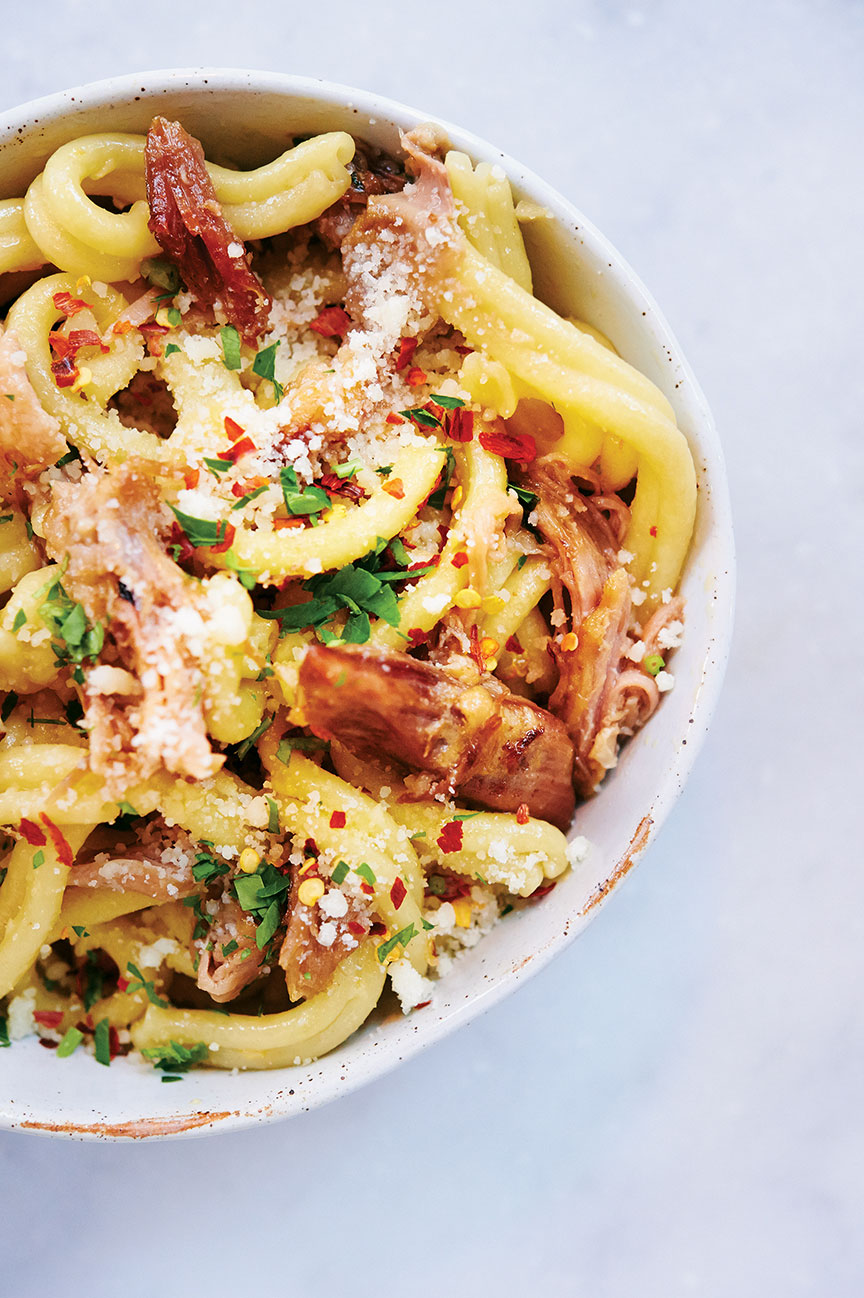
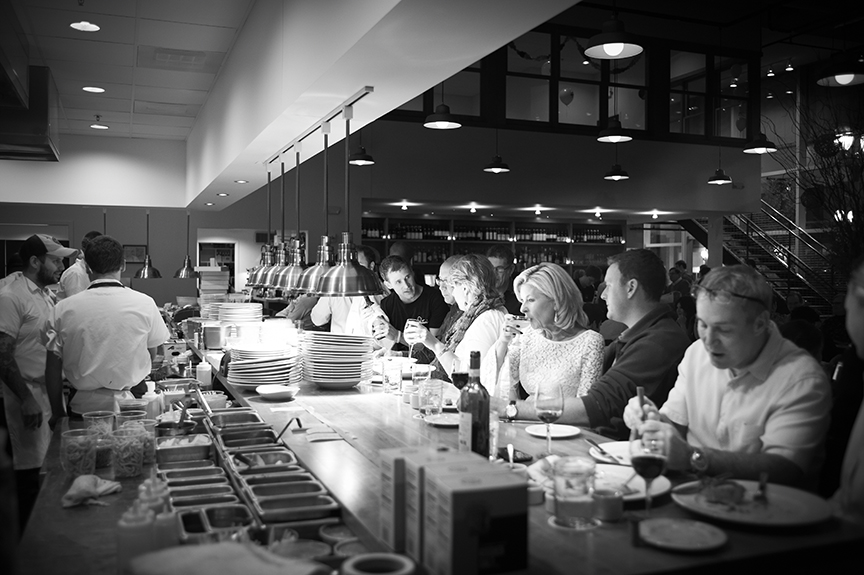
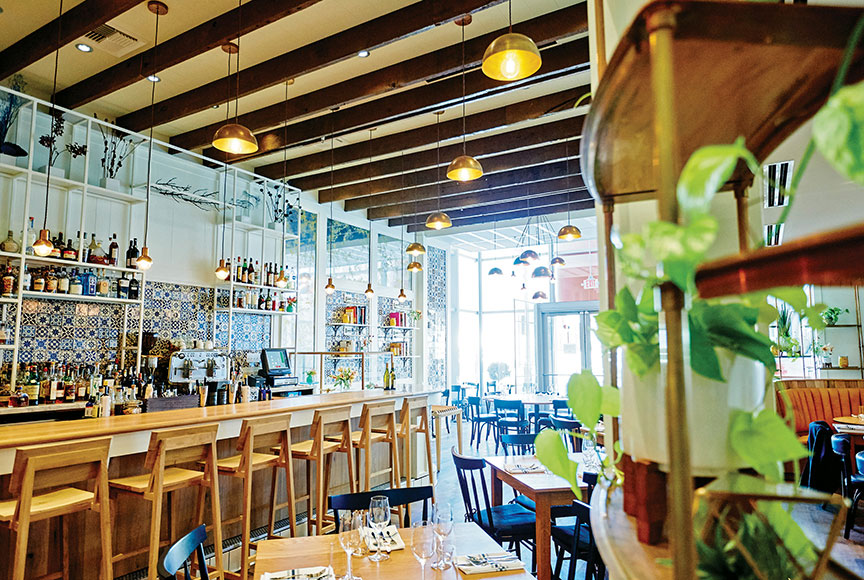
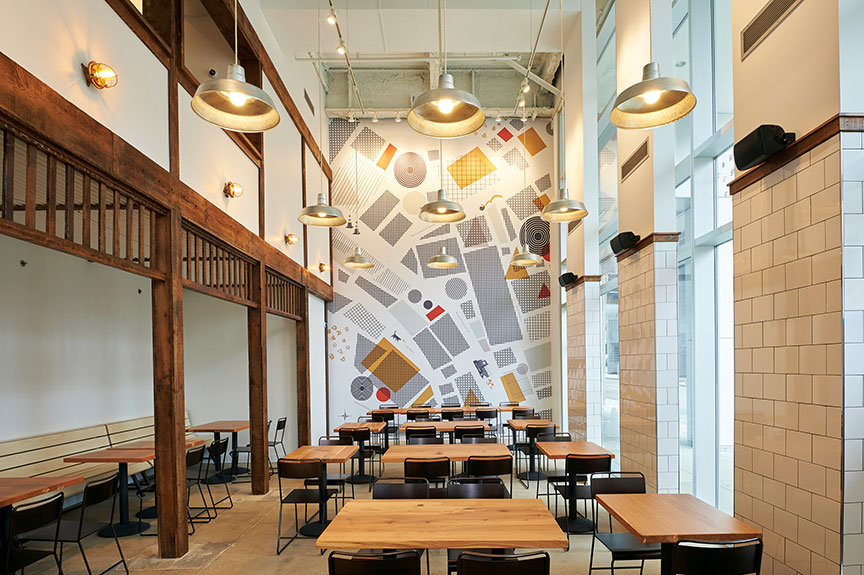
Niche was originally conceived as an unpretentious contemporary American restaurant, but an older clientele with fine dining expectations forced Craft to reinvent it as more of a special occasion restaurant. The servers, originally wearing tee-shirts, switched to collared shirts and pressed aprons, while the china was upgraded, explains Craft, who admits, “That slippery slope into fine dining pushed me to become a more creative and ambitious chef.”
Craft subsequently opened Brasserie by Niche, an authentic French bistro that reflects his love of Paris, Porano for quick-service Italian cooking, Pastaria for organic pastas, and mixology-driven Taste. While he acknowledges St. Louis lacks the wealth of dining found in its rival Midwestern city of Chicago, he contends, “There may not be a chic modern restaurant on every block, but the ones that succeed here are special.” In the pipeline for Craft is Pastaria Nashville, his first venture in neighboring Tennessee.
The James Beard Award-winning chef is perhaps the greatest single ambassador for Missouri-sourced ingredients. At the height of Craft’s commitment to local foods, 97 percent of the ingredients on Niche’s menu were produced in the Show Me State, including the onions going into stock for sauces, caviar from local rivers and even wine from Missouri vineyards. “It definitely generated a sense of pride in home-raised Missouri products,” says Craft. Insisting Missouri remains an unpretentious, approachable place, he suggests, “The hot summers and cold winters produce real people, and the vegetables are the same way, more humble and less precious.” Because of the movement that Craft spearheaded, there are now farmers and ranchers offering to grow vegetables or raise animals specifically for the needs of local chefs.
Craft shuttered Niche last year after a decade-long run, citing the intensity of maintaining standards at the city’s top-rated restaurant. “The competition begins to wear on you, and you begin to forget why you decided to cook in the first place,” says the chef, who converted the space into Sardella, a less expensive restaurant that celebrates his passion for Italian cooking.
A signature dish at Sardella is charred butternut squash with roasted garlic custard, Calabrian chile vinaigrette and basil that Craft describes as having bright flavors and a spicy, almost Thai-like quality even though all of the ingredients are Italian. “It’s an Italian dish that you’d never find in Italy,” quips the chef.
Gerard Craft and St. Louis have been good for one another, with the 37-year-old chef offering a diversity of local restaurants that may be the product of global influences but are true to their Missouri heritage.
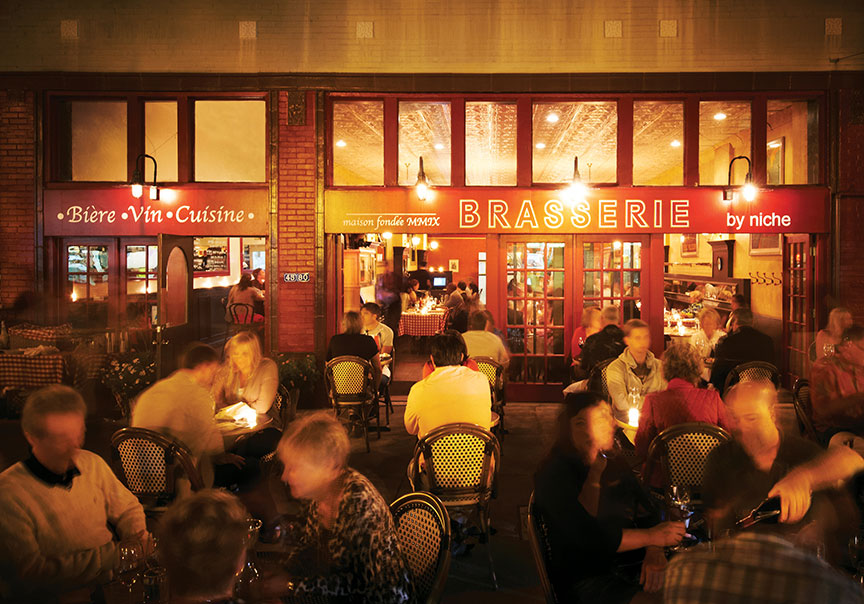
Photos courtesy of Greg Rannells
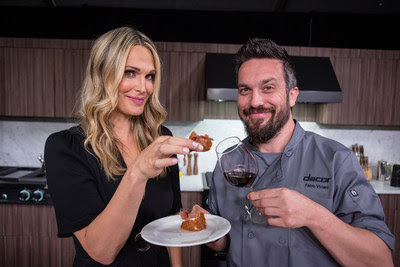
Today’s luxury kitchen is a hub for entertainment, creativity and great conversation, and premium home appliance manufacturer Dacor is turning the industry on its head with its new Modernist Collection. The revolutionary suite of kitchen appliances champions the luxury kitchen as a place to entertain and connect with friends and family. To introduce affluent, modern entertainers to its product line, Dacor partnered with Pebble Beach Food & Wine, one of the world’s preeminent culinary festivals, to set the stage for great entertainment and exceptional epicurean experiences.

For Dacor’s signature event on Friday evening, “Dinnertime Meets Showtime,” model and actress Molly Sims entertained an intimate group of distinguished diners, sharing moments from her career, life as a mother and culinary travels. Using Dacor’s cooking products, “Top Chef” alum Fabio Viviani translated her stories into a mouth-watering meal memoir for guests to enjoy.
Additional celebrity chefs showcased the Dacor kitchen suites throughout the weekend through unique cooking demonstrations in the Dacor Entertainers’ Pavilion. Culinary talent included Chefs Naomi Pomeroy of Portland’s Beast, Graham Elliot (“Top Chef,” “Master Chef” and “Master Chef Junior”) of his eponymous Michelin-starred Chicago restaurant, and chef, restaurateur, author and TV personality Curtis Stone of Los Angeles restaurants Maude and Gwen.
Cooking demos highlighted Dacor’s existing Heritage Collection and the new Modernist Collection. Available in graphite and standard stainless steel, the Modernist Collection is a full suite of sophisticated luxury kitchen appliances hallmarked by an entirely new approach to how appliances fit into today’s kitchen, with exceptional performance and consumer points of delight to provide an engaging stage for the modern entertainer.
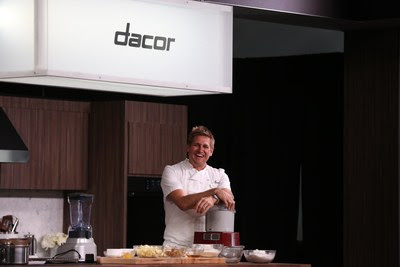
Dacor also displayed its latest column refrigeration with industry-leading performance and breathtaking design at “On the Rocks,” a unique event during Pebble Beach Food & Wine’s renowned Grand Tasting. The event was curated by mixologist Joshua Perry of Monterey’s Restaurant 1833 and featured drinks that highlighted Dacor Cocktail Ice™ produced by the dual ice-maker within the columns. Cocktail Ice™ melts slower so that guests were able to enjoy all the flavors and the experience of Joshua’s creations.
Building on more than 50 years of craftsmanship, the beautifully designed Modernist Collection represents a new generation of exceptional home appliances. The premium finish sets the stage for innovative and precise performance to delight today’s modern entertainers, style seekers and chefs alike. Created with durable yet luxurious materials and an array of thoughtfully designed consumer touchpoints—including Illumina™ Knobs, LCD control panels, SoftShut doors and hidden hinges—the Modernist Collection seeks to make every kitchen experience a memorable one.
For more information on the Modernist Collection, visit dacor.com/Modernist/.


